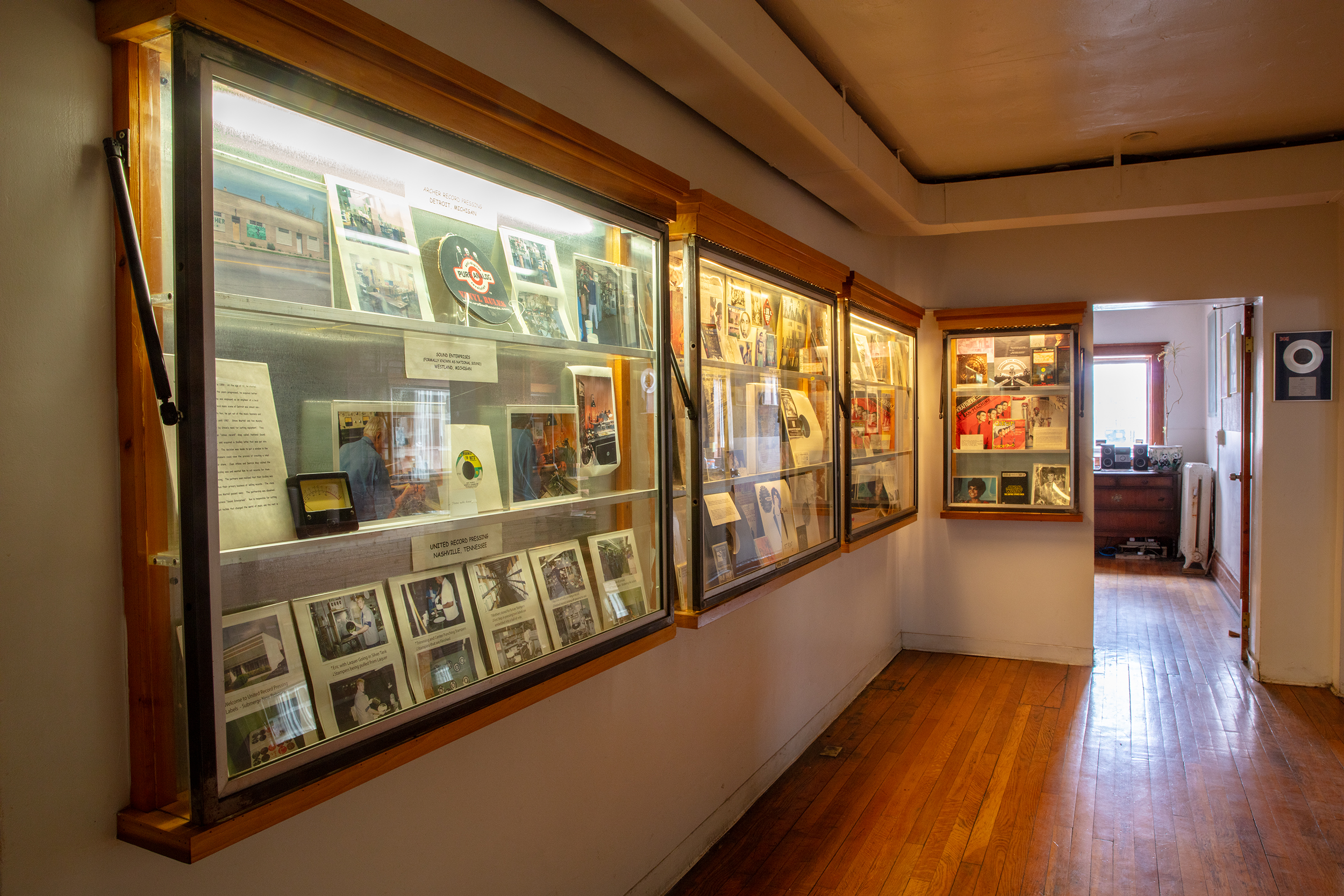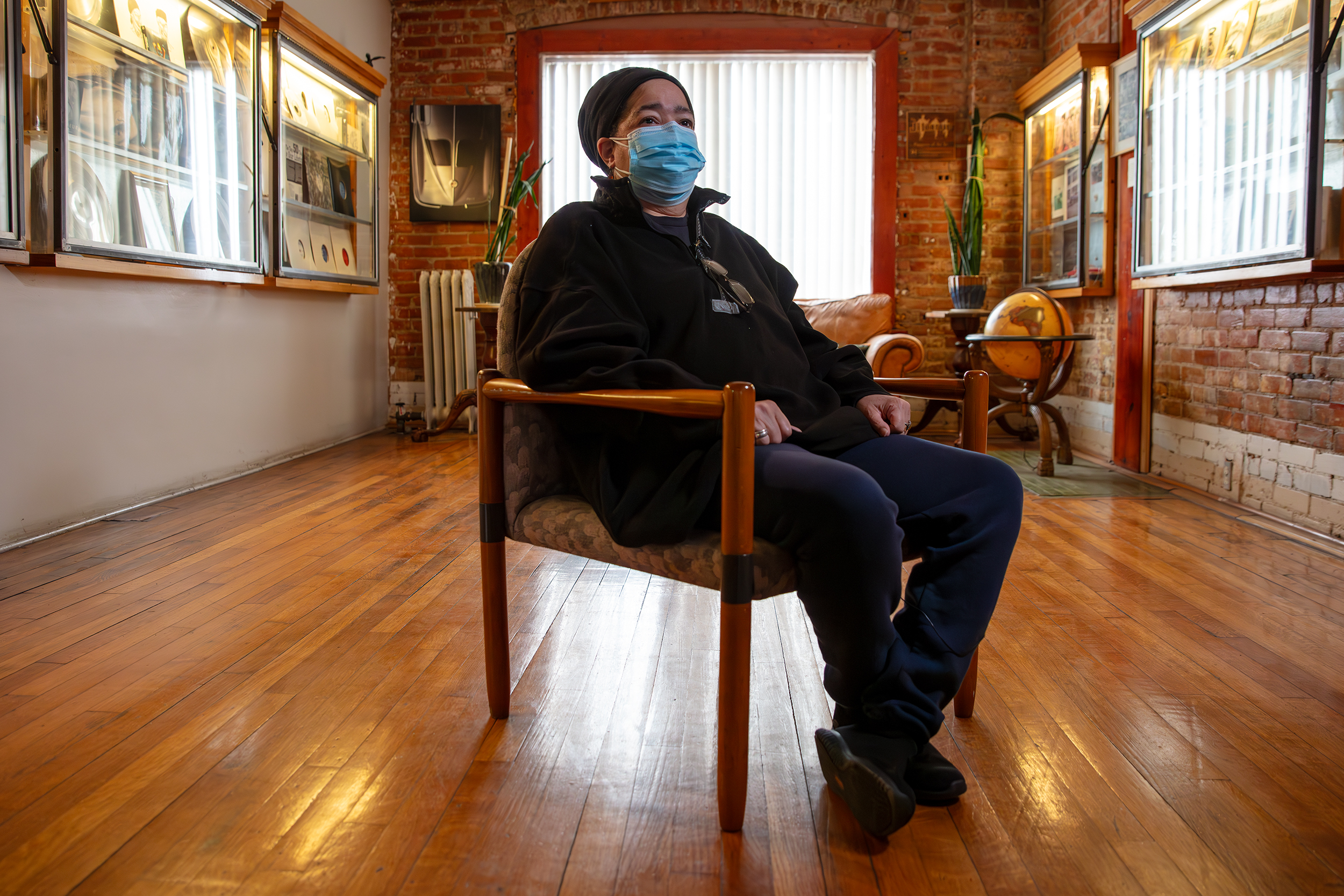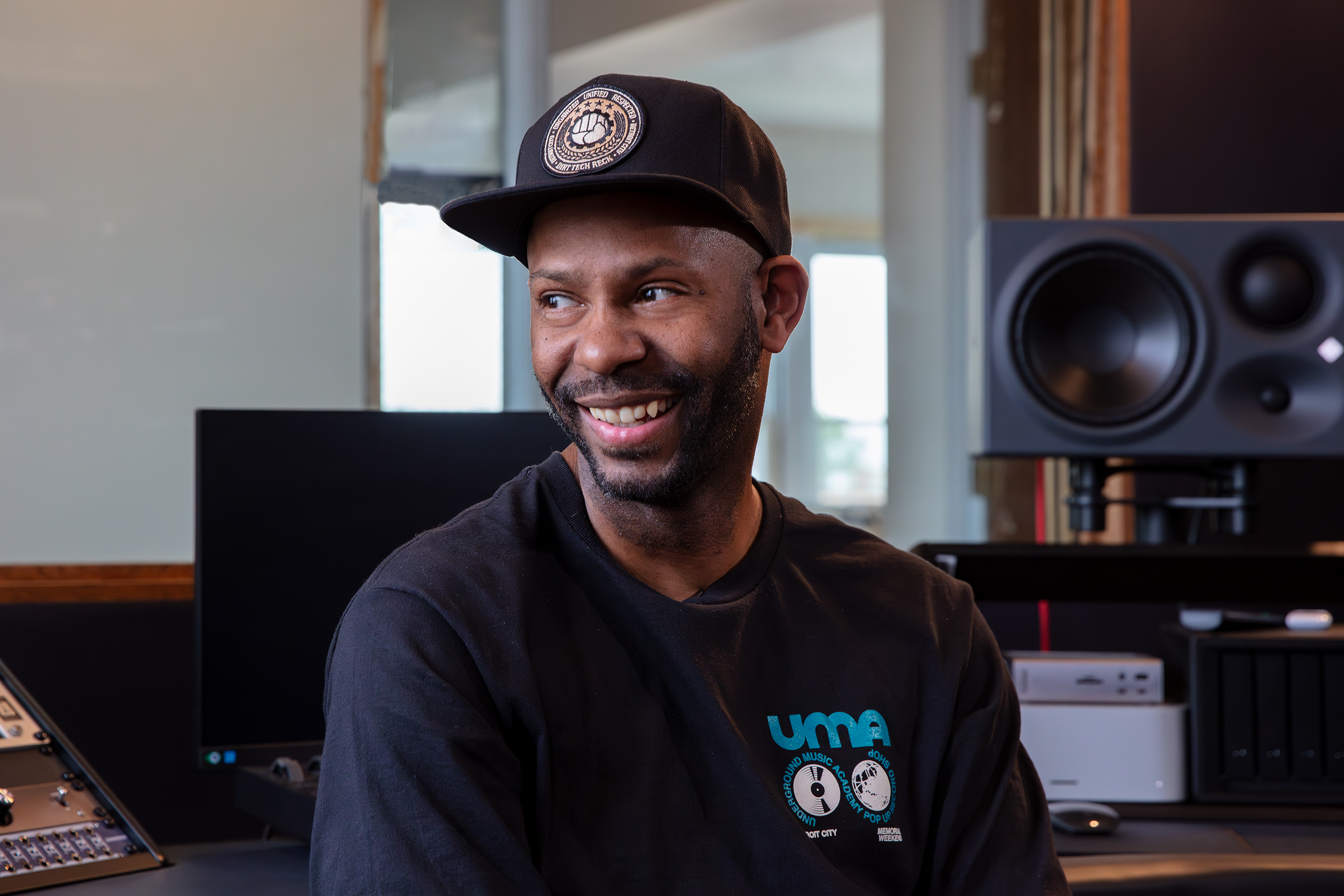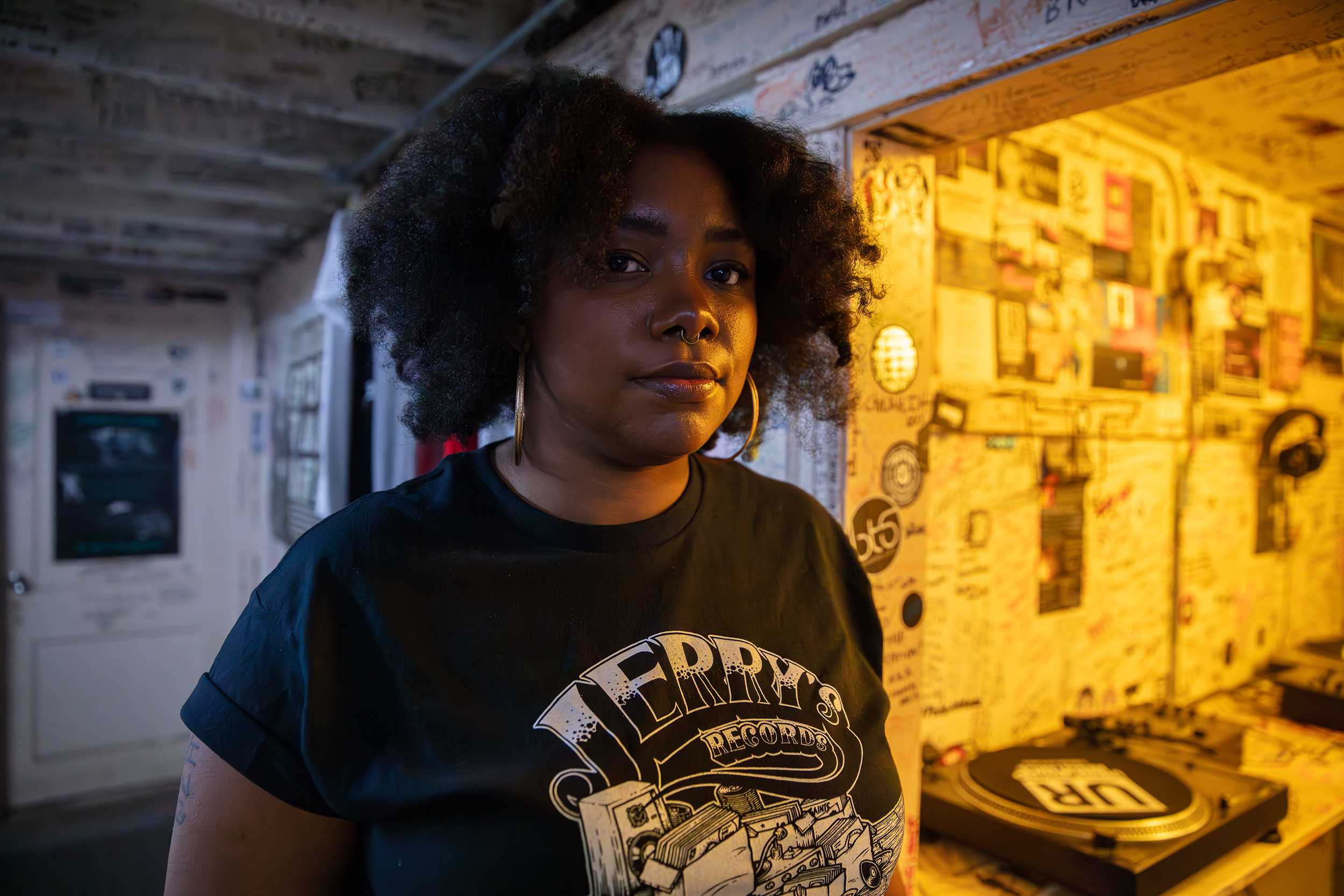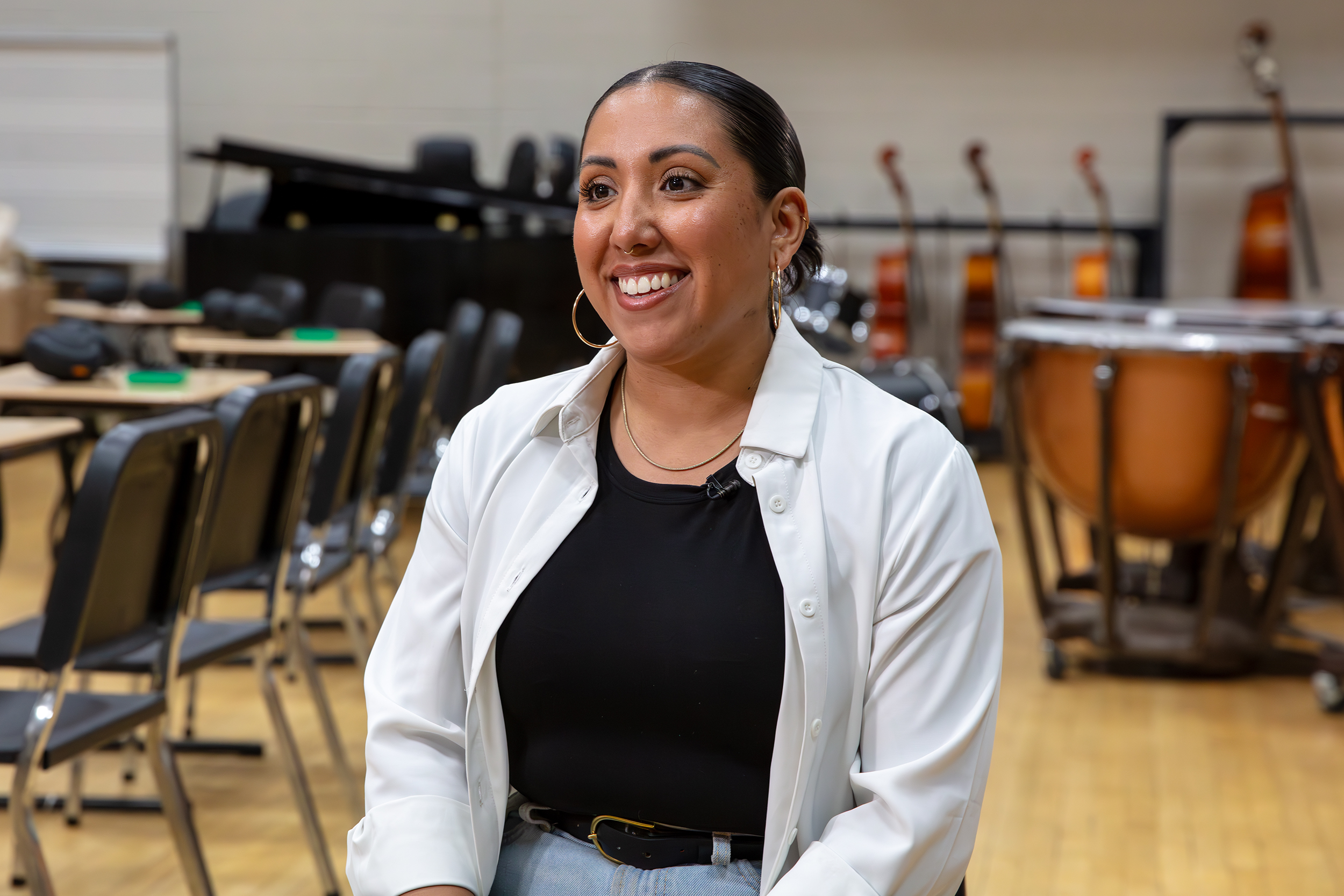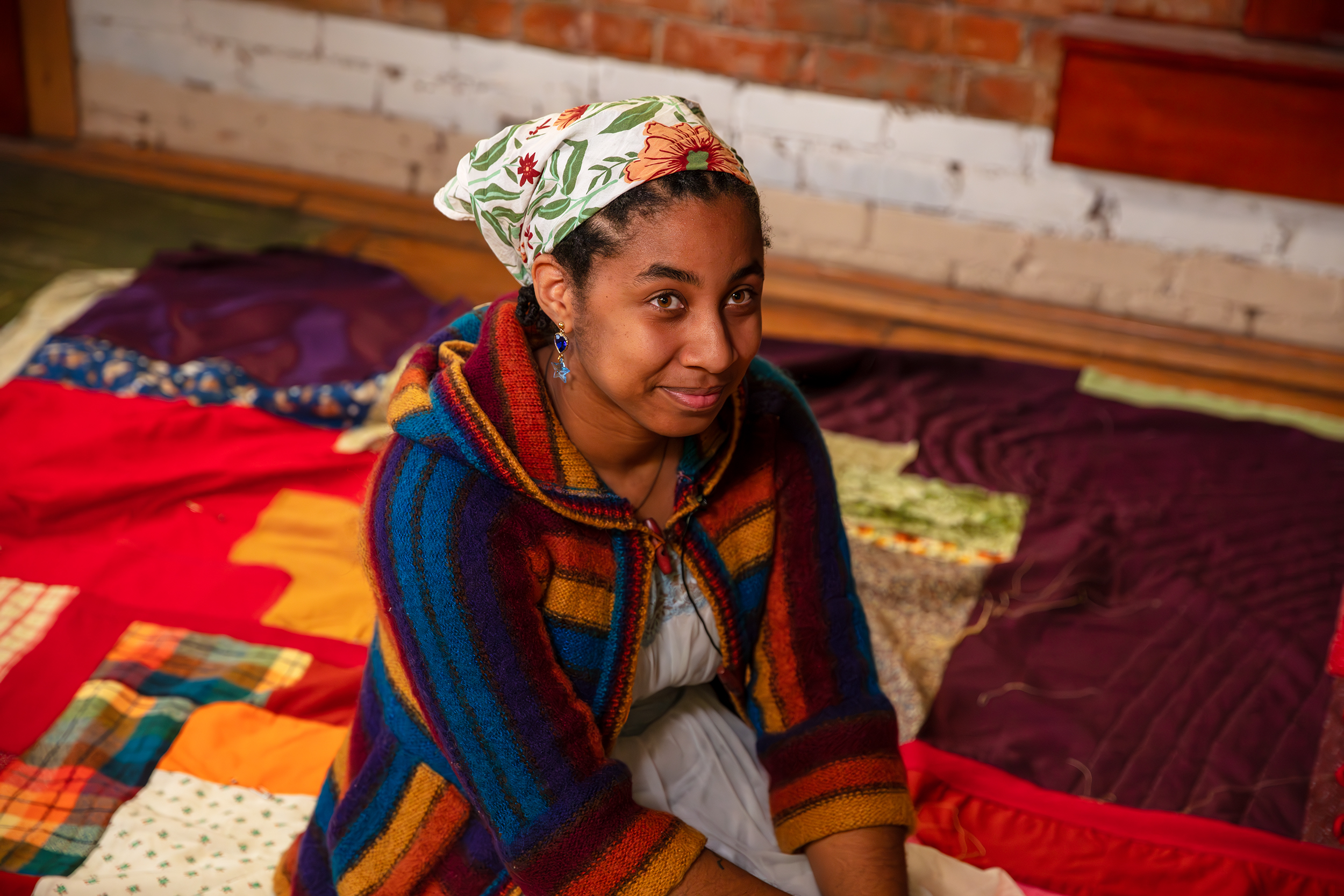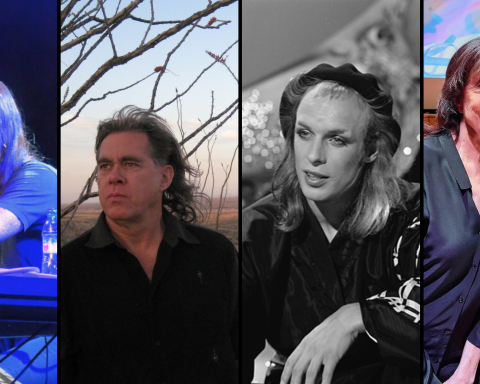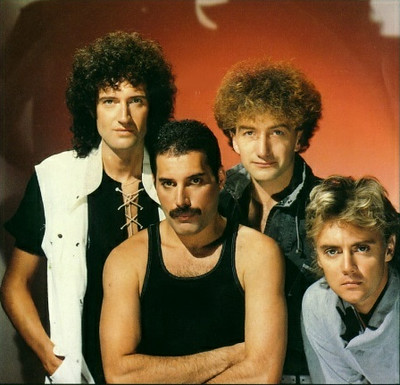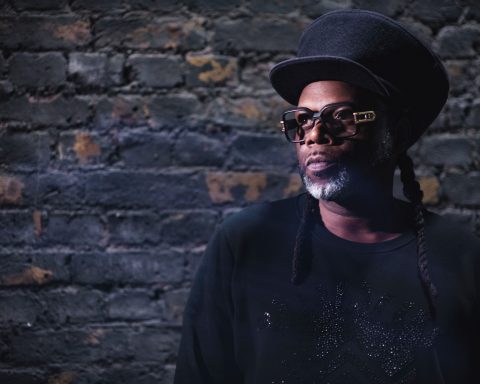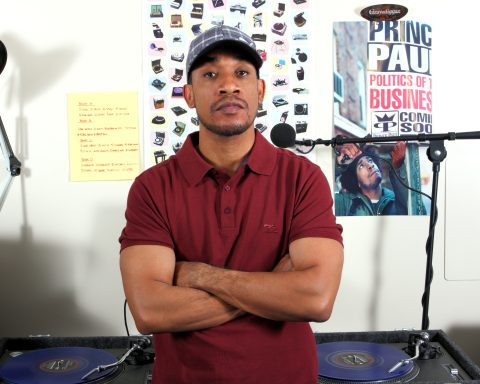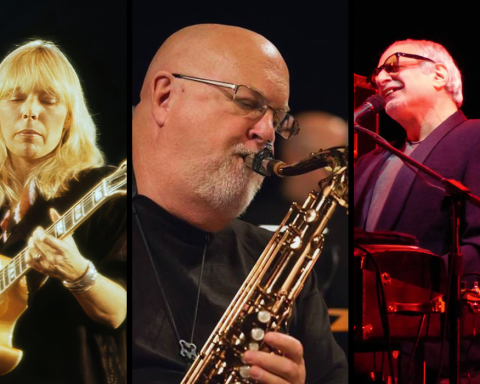“Resurget Cineribus” or “It will rise from the ashes,” goes the Detroit motto. This ethos applies both to the city as a whole and its robust musical community. Located on what locals affectionally call “The Boulevard,” the same strip as legendary one-stop production hub Motown, Submerge offers a tangible example of the “Detroit Way.” This multi-purpose environment—equal parts museum (Exhibit 3000), a curated record store (Somewhere in Detroit), and artist incubator—represents the interconnected Detroit electronic music community. In their own words, Underground Resistance founder “Mad” Mike Banks, historian Cornelius Harris, and other key players connect Submerge to the broader story of the city, touching on a history of rebirth, musical innovation, and the relentless pursuit of musical expression.
(Left to Right, Top Down)
- “Mad” Mike Banks: Musician, Record Producer, UR and Submerge Co-Founder
- Cornelius Harris: UR Label Manager, Cultural Advocate
- Bridgette Banks: Head of Submerge Shipping and Distribution
- Waajeed: Music Producer, Educator, UMA Founder
- Crystal Mioner: DJ, Submerge Artist Management
- Kamau Baaqi: Music Producer
- Maritza Figueroa-Garibay: Musician, Educator
- Saylem Celeste: Music Producer, Quilter
- De’Sean Jones: Musician, Educator


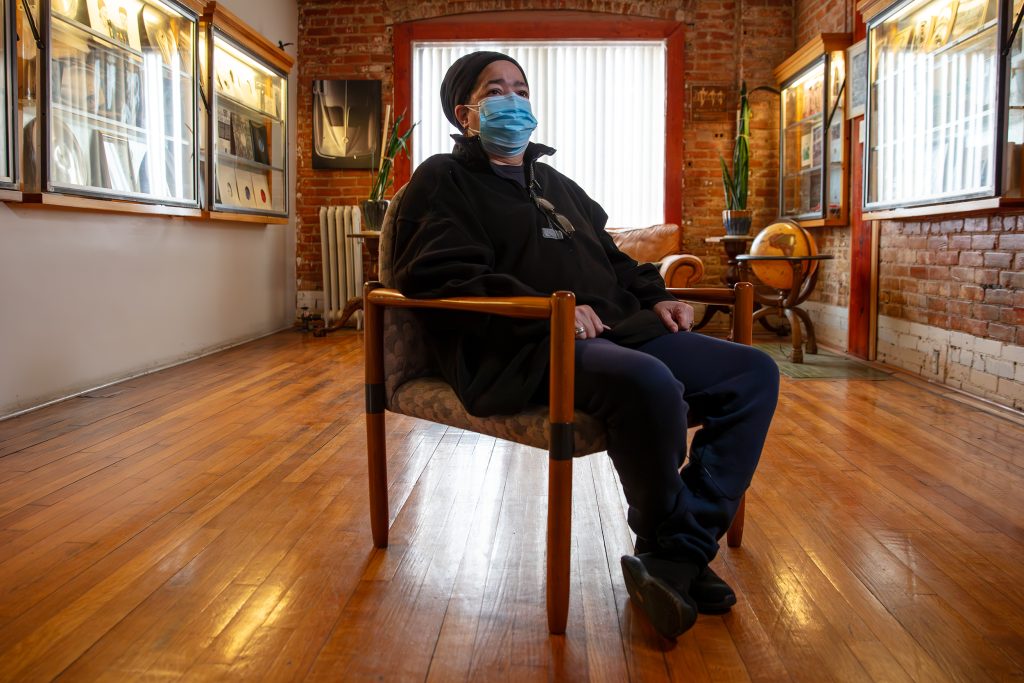
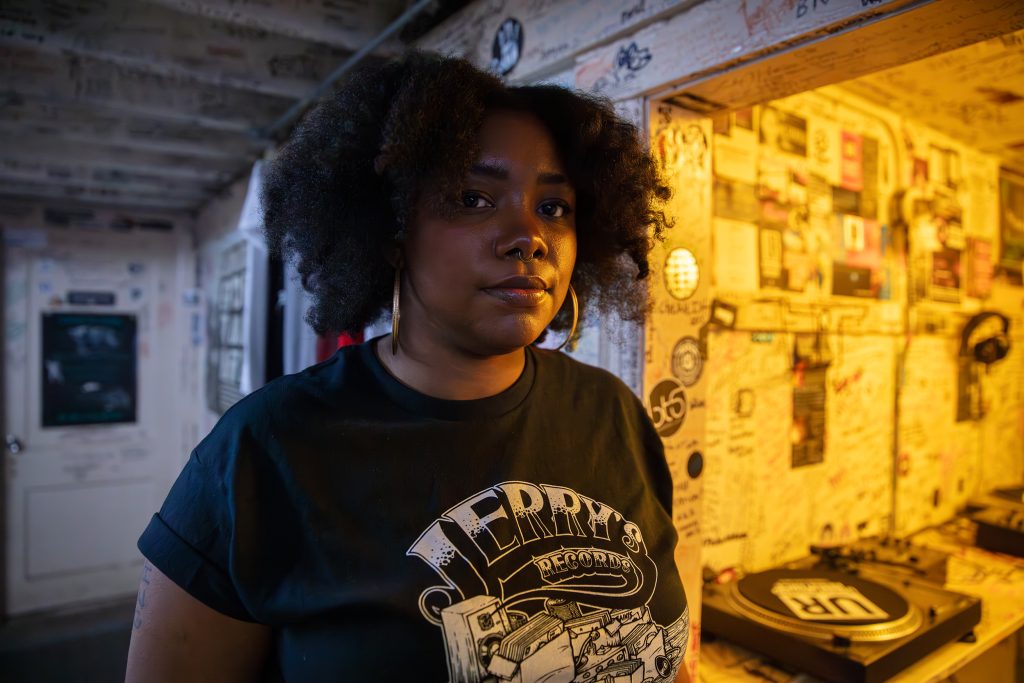
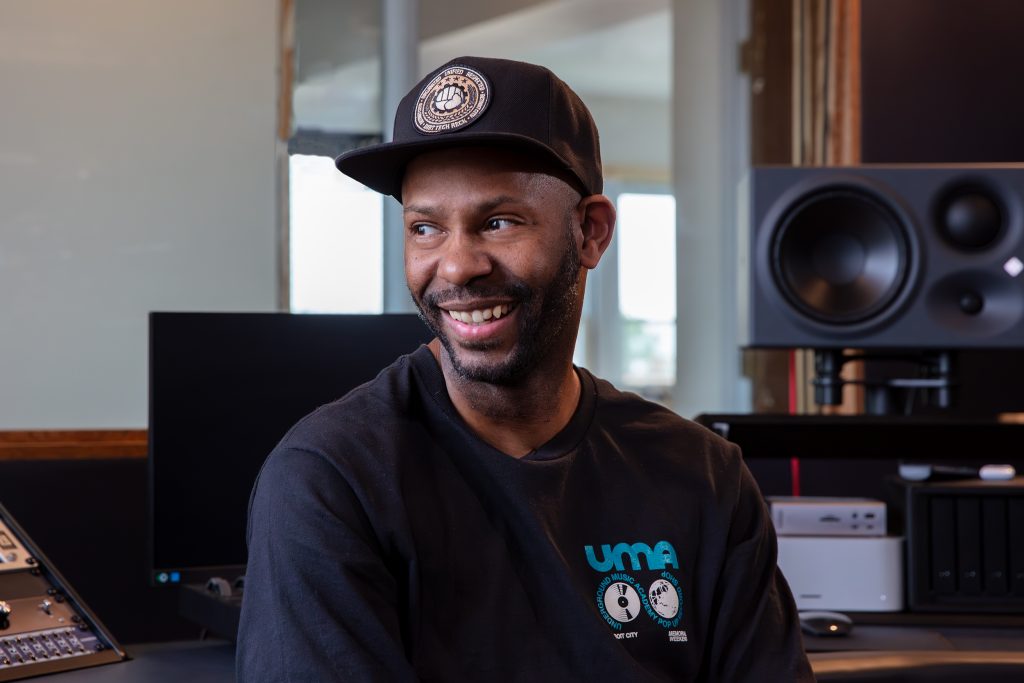


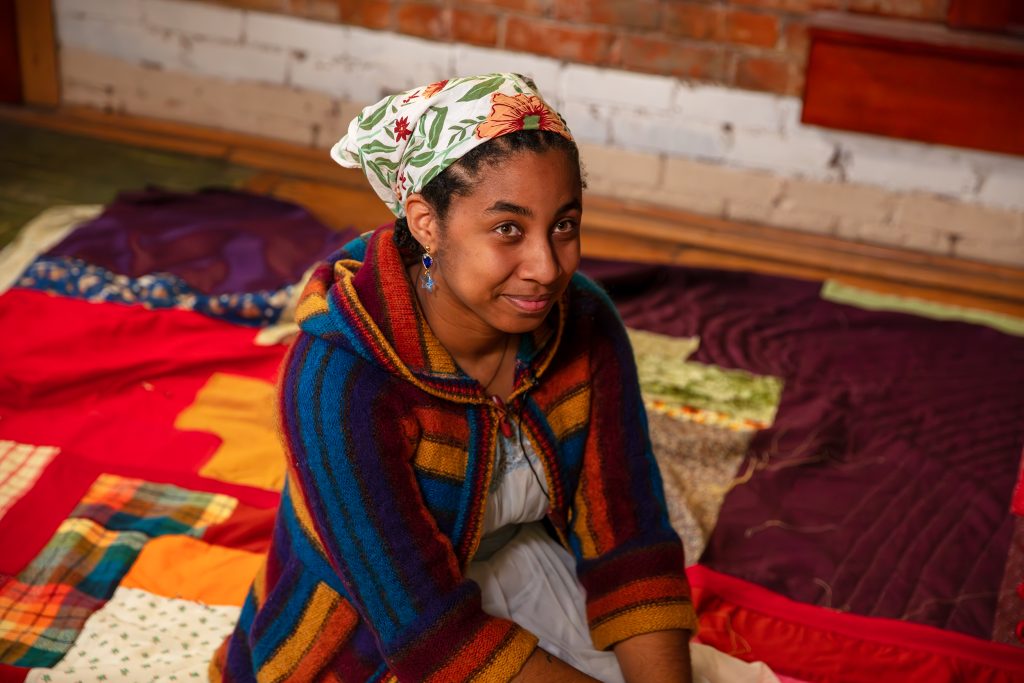
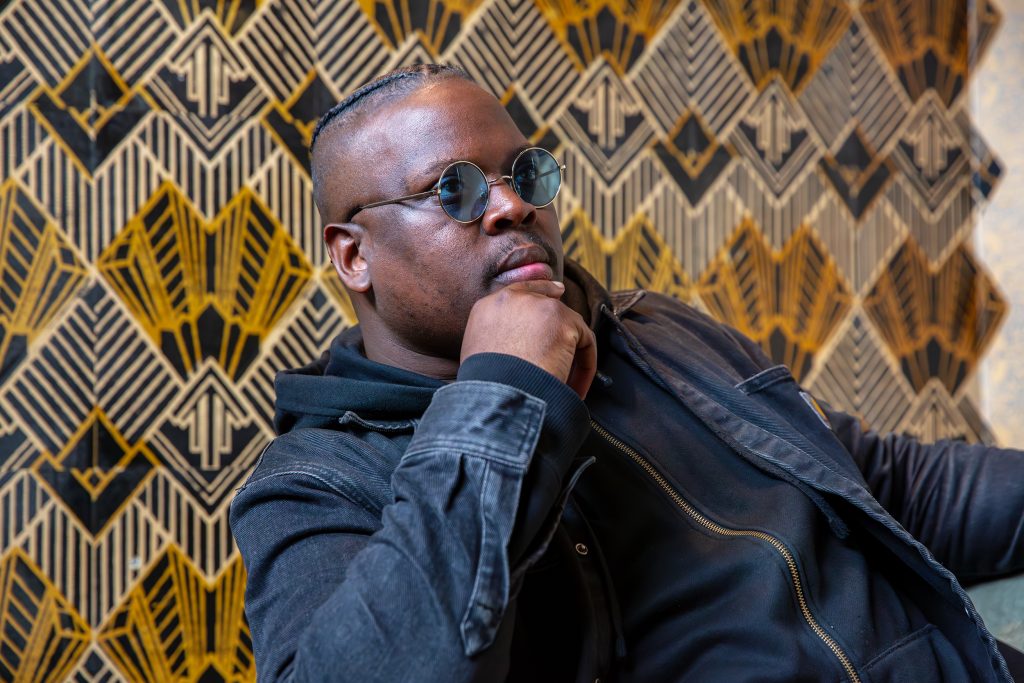
DETROIT LEADS THE WAY
DETROIT LEADS THE WAY
A Midwest metropolis with a gritty can-do spirit, Detroit is known as a hub of innovation, exemplified by its storied auto industry past. The same is true of its music. In addition to its rich jazz, blues, funk, and rock history, Detroit is ground zero for what came to be known as techno. At the same time, the city’s infrastructural challenges make its artistic perseverance even more extraordinary. The Submerge community explains how there is nowhere like Detroit.
A Midwest metropolis with a gritty can-do spirit, Detroit is known as a hub of innovation, exemplified by its storied auto industry past. The same is true of its music. In addition to its rich jazz, blues, funk, and rock history, Detroit is ground zero for what came to be known as techno. At the same time, the city’s infrastructural challenges make its artistic perseverance even more extraordinary. The Submerge community explains how there is nowhere like Detroit.
Dust Into Diamonds
“They say pressure can either turn something into dust or turn it into a diamond. And Detroit produced a lot of diamonds.” –Cornelius Harris
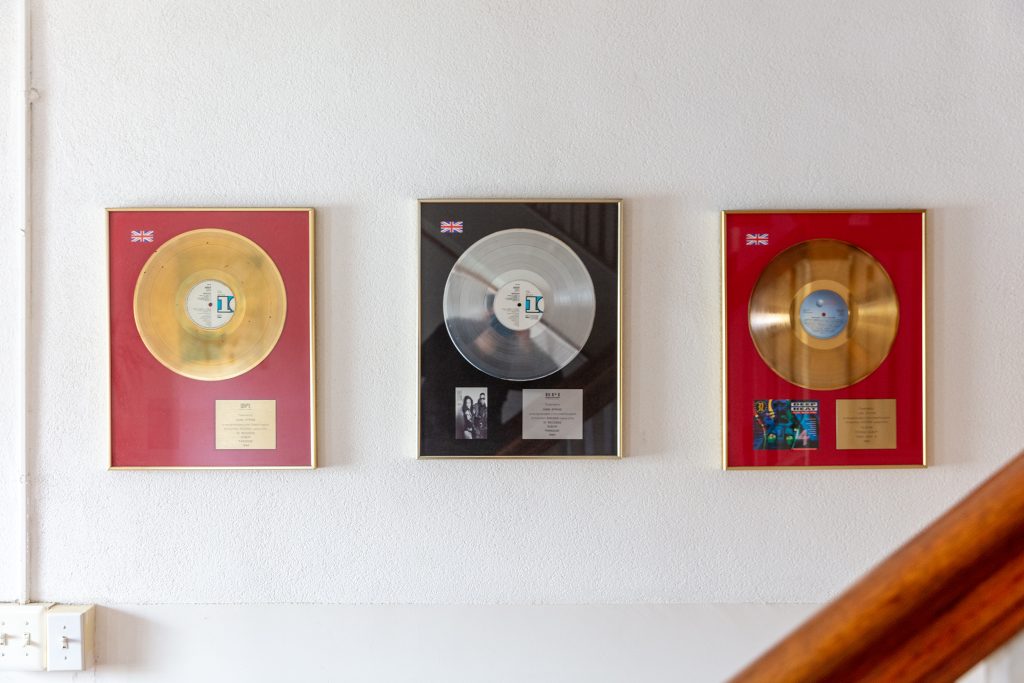
“I think collaboration is a thing that comes naturally here in Detroit. Because we’ve been failed by systems, we’ve learned to naturally depend on community to move forward.” –Waajeed

“Detroit was economically depressed but musically richer than anywhere in the world.
It’s all mixed up together. Musically, progressively, fashion-wise, and art-wise, we have some of the baddest.” –“Mad” Mike Banks
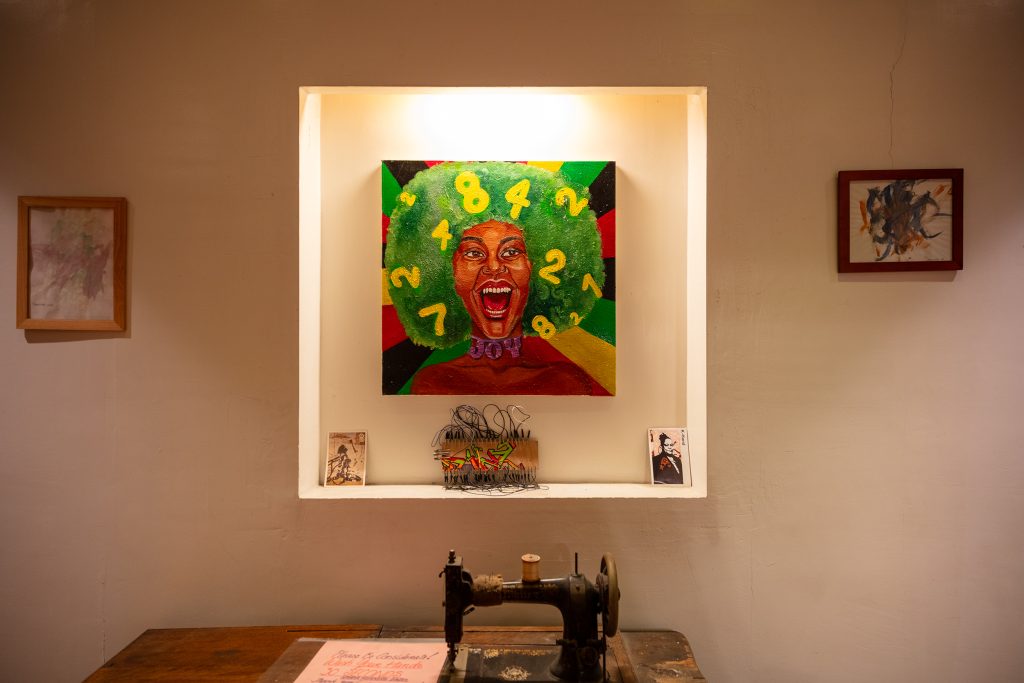
Deep Connections
“I think it’s the idea of being able to rebuild yourself, not allowing circumstances to determine your fate. The city kept coming back. That theme runs repeatedly. People assume the city is over, and from the ashes, it comes back.” –Cornelius Harris
“It’s like any other small town in the United States. We all coagulate in a special way. We all support one another. So in terms of community, we’re breaking these rules because we have one another to rely on.” –Waajeed

“Detroit is a big town with deep connections and legacies. What can we do to work on the infrastructure to make it appealing for young people to stay? Because if they’re not staying, there’s a gap in the culture.” –Crystal Mioner
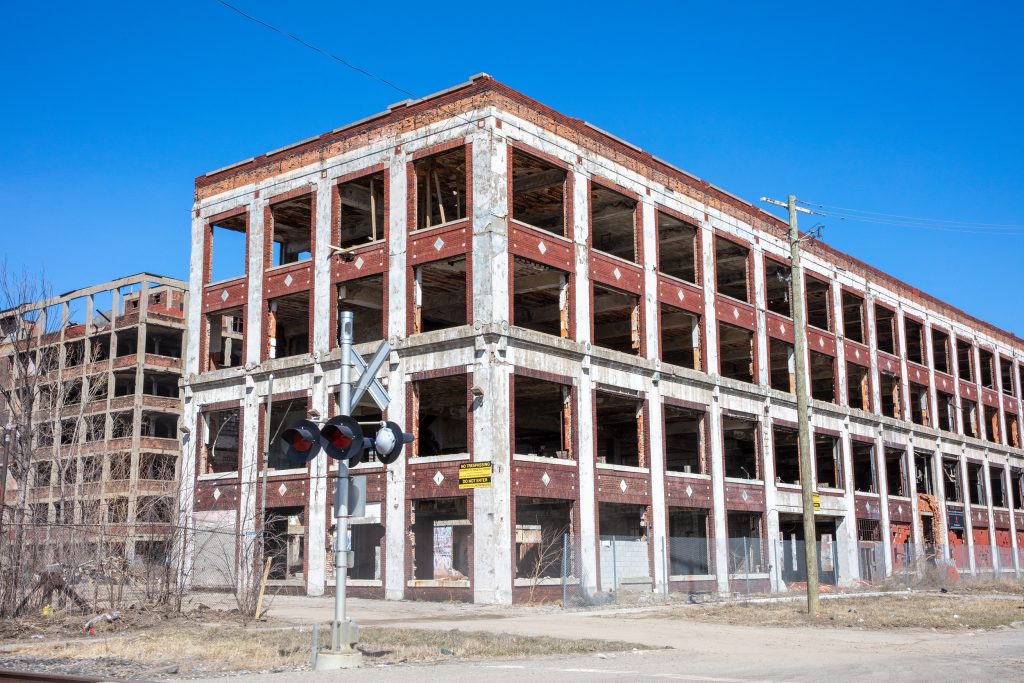
“When you look at what Motown did, it’s such a powerful example of a company that changed the entire way the music industry functions and altered the course of music globally.” –Cornelius Harris

“We don’t get shiny new toys. I started making blankets because I was cold and needed something to put over me. The idea behind patchwork translates to music because it’s like trying to cobble together what can only be felt here.” –Saylem Celeste

Standard of Innovation
“Historically, when you look at Africans here, there hasn’t been a lot of support. People built this stuff themselves. When you reach the end of your rope, tie a knot and hang on. It’s about freedom and liberation and movin’ up in the face of all this negativity.” –Cornelius Harris
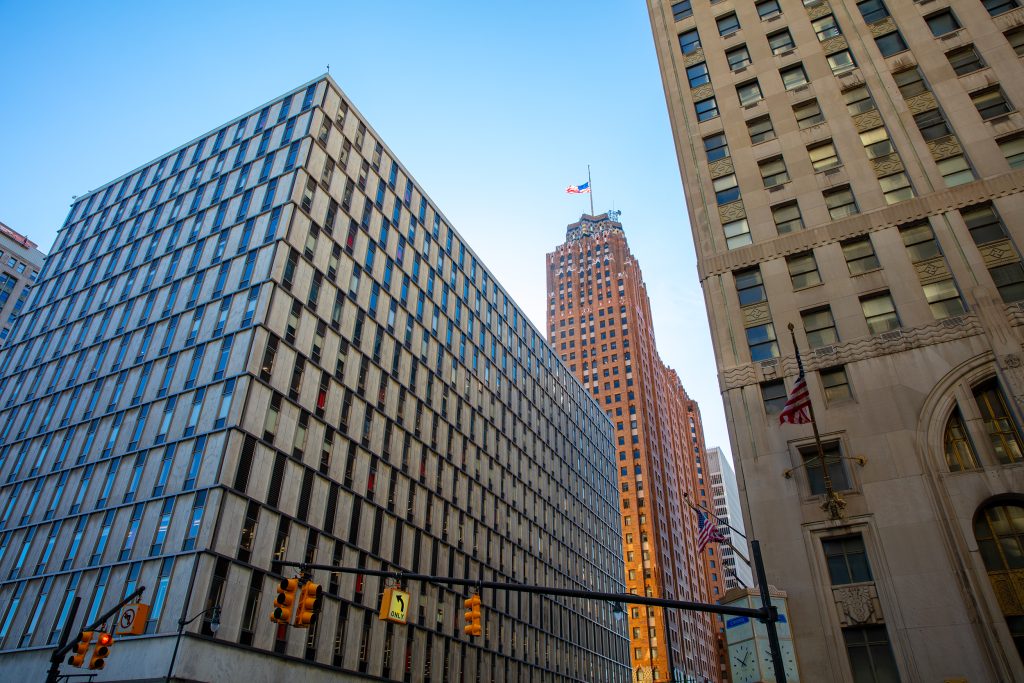
“There’s a really high sonic standard and a standard of innovation. This is a city of innovation. We lead the way.” –De’Sean Jones
“The auto industry had gone to hell; there were all these negative factors. Yet that was when the birth of techno came about.” –Cornelius Harris
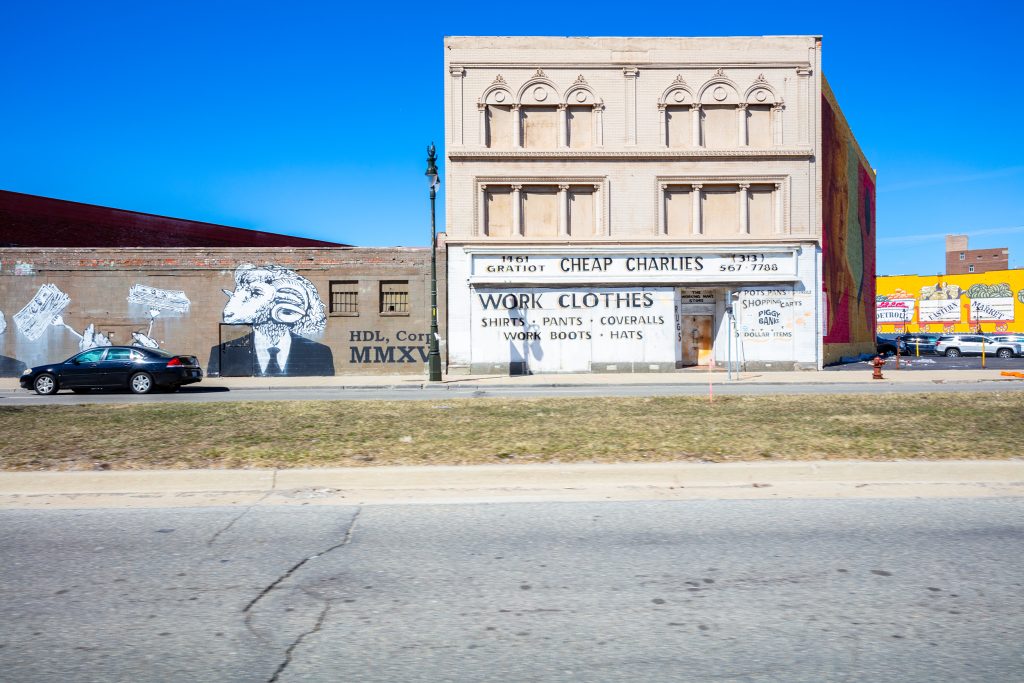
A Fertile Ground
“Detroit is a very deep, fertile ground for music, experimenting, and playing. You have a lot of space here.” –Saylem Celeste
“Detroit has had such a unique history in its formation—that perfect temperature for people to express themselves. That culture that was birthed in Detroit has gotten passed down. Everyone knows this is the place for music.” –Kamau Baaqi
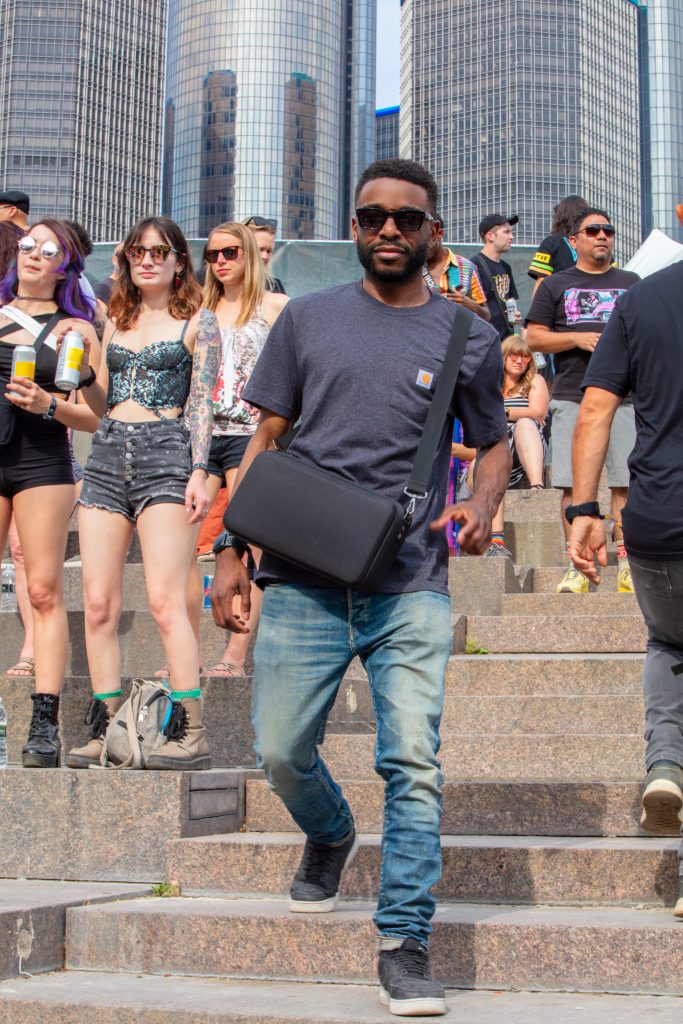
“Detroit is lucky to have Archer Record Pressing plant in town. That limits the time between the creation and distribution of the record. In the ’90s, it gave Detroit just enough of an edge; they have been miles ahead since.” –Crystal Mioner
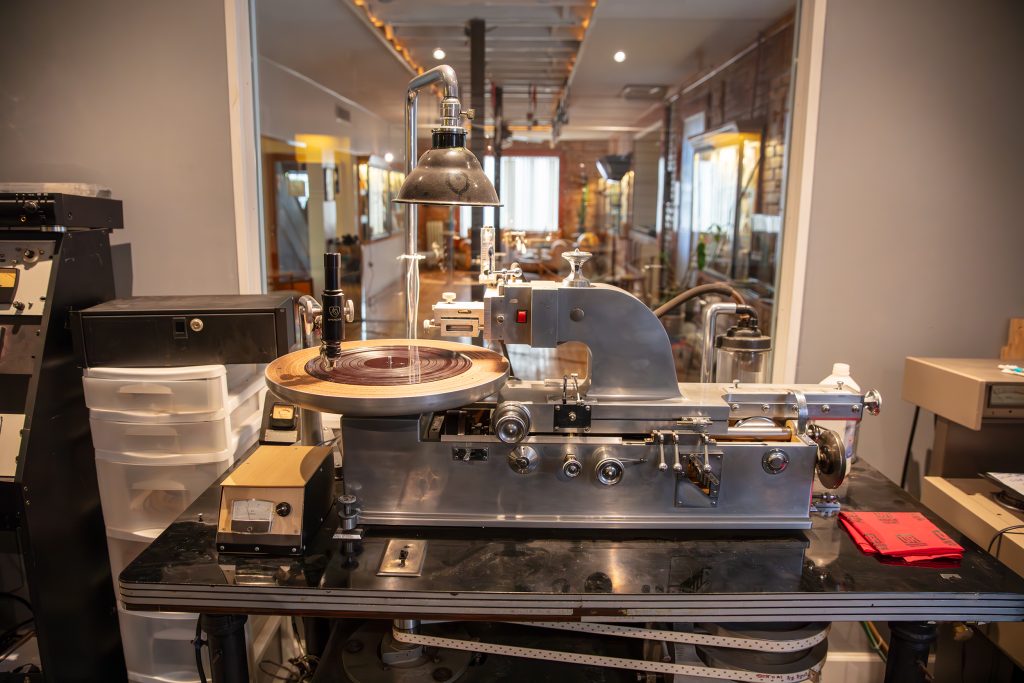
“Daft Punk, they were big Detroit fans. Detroit influenced them. From the amount of people that come to these electronic music festivals, there’s a lot more potential in Detroit than I think some of our politicians can see.” –“Mad” Mike Banks

Dust into Diamonds
“They say pressure can either turn something into dust or turn it into a diamond. And Detroit produced a lot of diamonds.” –Cornelius Harris


“I think collaboration is a thing that comes naturally here in Detroit. Because we’ve been failed by systems, we’ve learned to naturally depend on community to move forward.” –Waajeed
“Detroit was economically depressed but musically richer than anywhere in the world.
It’s all mixed up together. Musically, progressively, fashion-wise, and art-wise, we have some of the baddest.” –“Mad” Mike Banks


Deep Connections
“I think it’s the idea of being able to rebuild yourself, not allowing circumstances to determine your fate. The city kept coming back. That theme runs repeatedly. People assume the city is over, and from the ashes, it comes back.” –Cornelius Harris
“It’s like any other small town in the United States. We all coagulate in a special way. We all support one another. So in terms of community, we’re breaking these rules because we have one another to rely on.” –Waajeed
“Detroit is a big town with deep connections and legacies. What can we do to work on the infrastructure to make it appealing for young people to stay? Because if they’re not staying, there’s a gap in the culture.” –Crystal Mioner


“When you look at what Motown did, it’s such a powerful example of a company that changed the entire way the music industry functions and altered the course of music globally.” –Cornelius Harris
“We don’t get shiny new toys. I started making blankets because I was cold and needed something to put over me. The idea behind patchwork translates to music because it’s like trying to cobble together what can only be felt here.” –Saylem Celeste


Standard of Innovation
“Historically, when you look at Africans here, there hasn’t been a lot of support. People built this stuff themselves. When you reach the end of your rope, tie a knot and hang on. It’s about freedom and liberation and movin’ up in the face of all this negativity.” –Cornelius Harris
“There’s a really high sonic standard and a standard of innovation. This is a city of innovation. We lead the way.” –De’Sean Jones
“The auto industry had gone to hell; there were all these negative factors. Yet that was when the birth of techno came about.” –Cornelius Harris


A Fertile Ground
“Detroit is a very deep, fertile ground for music, experimenting, and playing. You have a lot of space here.” –Saylem Celeste
“Detroit has had such a unique history in its formation—that perfect temperature for people to express themselves. That culture that was birthed in Detroit has gotten passed down. Everyone knows this is the place for music.” –Kamau Baaqi
“Detroit is lucky to have Archer Record Pressing plant in town. That limits the time between the creation and distribution of the record. In the ’90s, it gave Detroit just enough of an edge; they have been miles ahead since.” –Crystal Mioner
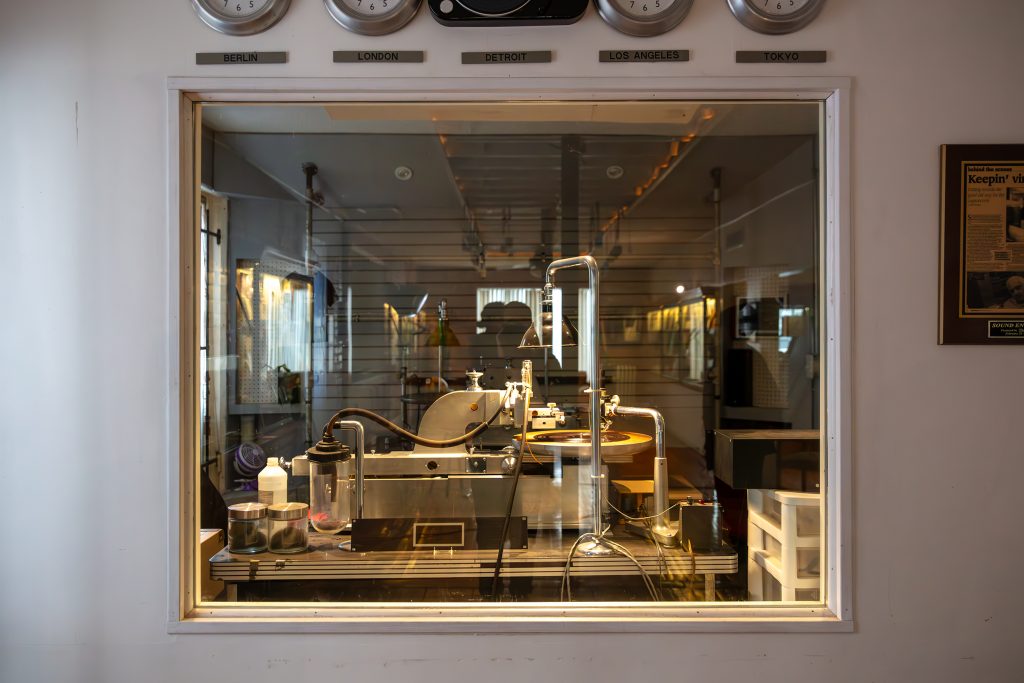

“Daft Punk, they were big Detroit fans. Detroit influenced them. From the amount of people that come to these electronic music festivals, there’s a lot more potential in Detroit than I think some of our politicians can see.” –“Mad” Mike Banks
A GALAXY OF INSPIRATION
A GALAXY OF INSPIRATION
Drawing on everything from the interstellar scope of Afrofuturism to the genre-shattering electronic sounds of Yellow Magic Orchestra and Kraftwerk, Underground Resistance, Submerge, and Detroit resist easy categorization. In the birthplace of Motown and the spiritual home of Parliament-Funkadelic, the lineage of inspiration runs deep. Moreover, the twin legacies of radio and live DJ culture helped shape the cultural landscape of this wildly eclectic community.
Drawing on everything from the interstellar scope of Afrofuturism to the genre-shattering electronic sounds of Yellow Magic Orchestra and Kraftwerk, Underground Resistance, Submerge, and Detroit resist easy categorization. In the birthplace of Motown and the spiritual home of Parliament-Funkadelic, the lineage of inspiration runs deep. Moreover, the twin legacies of radio and live DJ culture helped shape the cultural landscape of this wildly eclectic community.
Afrofuturism
“Afrofuturism—it’s something that has existed since the first enslaved African got here. It was there from the beginning and has been part of the history. People talk about Sun Ra calling himself alien, and George Clinton brought it to the masses.” –Cornelius Harris
“George Clinton, a lot of his stuff was unconventional, the way he approached it, I love church music too. That’s the root of soul music, I love Seattle grunge, ‘Moskow Diskow’ by Telex, Gino Socio, the Italian stuff, it was global.” –“Mad” Mike Banks
Sound Memory
“Radio was a function of the community, a source of information. The Electrifying Mojo came from that, opening up people’s minds. He said it was OK to be different, to not fit into a box.” –Cornelius Harris
“You have to unlearn and find who you really are. I think the rhythms come with us and travel through genetics. The funk factor, you can’t define it.” –“Mad” Mike Banks

“Somebody can teach you how to use a drum machine, but they can’t teach you what to do with that power. That’s one of the things I’ve learned from people like Berry Gordy, these elders.” –Waajeed
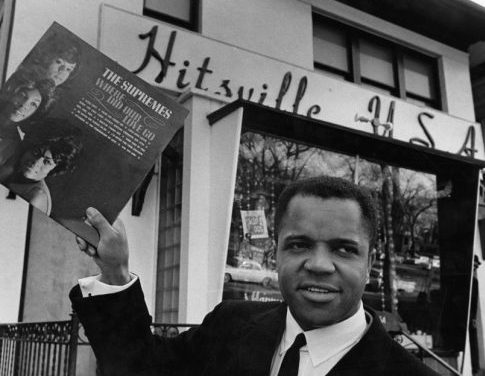
“In high school, I used to listen to Detroit music on the radio. I had that sound memory, and seeing it performed live pierced my soul. I was like, ‘This is the real stuff.'” –Maritza Figueroa-Garibay
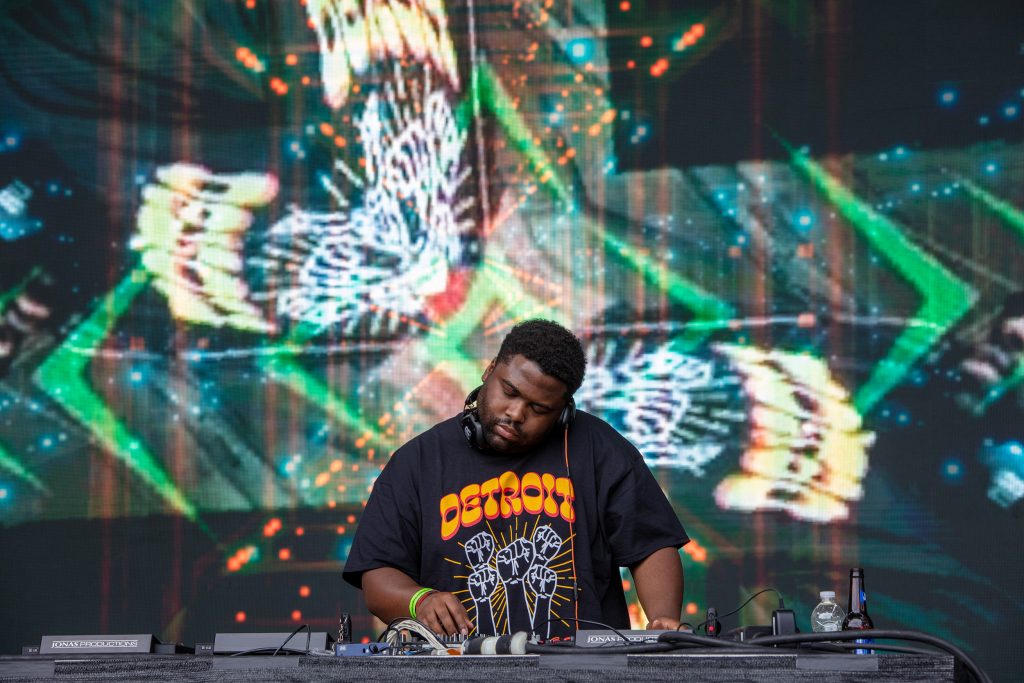
Mentorship and Influence
“I had a mentor Don Davis who owned United Sounds Studio where Parliament recorded. Don taught us about publishing and showed us the evils of the record company. For us, the underground was real.” –“Mad” Mike Banks
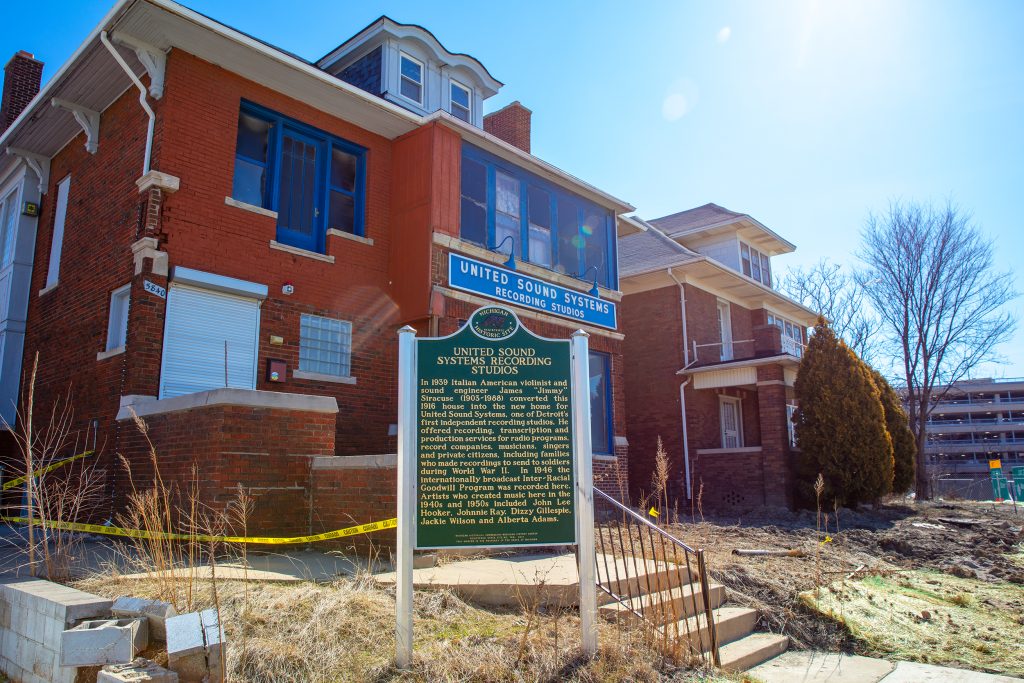
“The premise of techno is that it’s futuristic music. You can’t talk about the future and not talk about youth.” –Cornelius Harris
“A lot of people came over to get Northern Soul records. They heard Ron Murphy cutting all this stuff and ended up going back to England. Juan broke out with ‘Alleys Of Your Mind’ in ’81. For a good seven or eight years there, it was Detroit, Chicago, and Mantronix from New York.” –“Mad” Mike Banks
“There’s no better way to get hands-on training than from a mentor and master like Mike Banks. That’s a unique class to be a part of—those that are part of the history of Detroit.” –De’Sean Jones
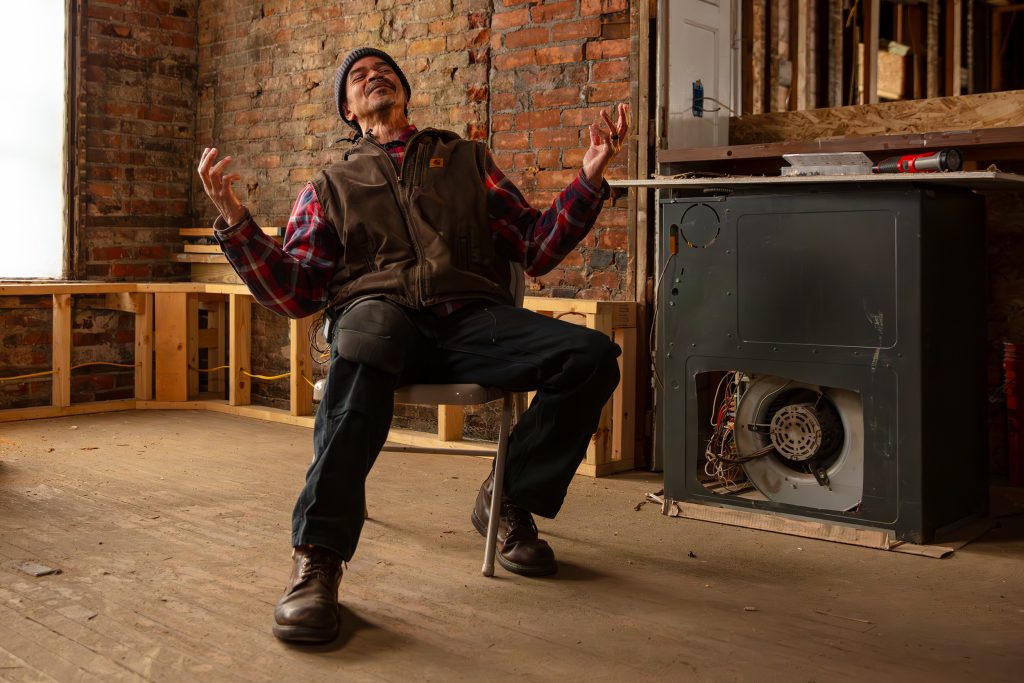
Afrofuturism
“Afrofuturism—it’s something that has existed since the first enslaved African got here. It was there from the beginning and has been part of the history. People talk about Sun Ra calling himself alien, and George Clinton brought it to the masses.” –Cornelius Harris
“George Clinton, a lot of his stuff was unconventional, the way he approached it, I love church music too. That’s the root of soul music, I love Seattle grunge, ‘Moskow Disko’ by Telex, Gino Socio, the Italian stuff, it was global.” –“Mad” Mike Banks
Sound Memory
“Radio was a function of the community, a source of information. The Electrifying Mojo came from that, opening up people’s minds. He said it was OK to be different, to not fit into a box.” –Cornelius Harris

“You have to unlearn and find who you really are. I think the rhythms come with us and travel through genetics. The funk factor, you can’t define it.” –“Mad” Mike Banks
“Somebody can teach you how to use a drum machine, but they can’t teach you what to do with that power. That’s one of the things I’ve learned from people like Berry Gordy, these elders.” –Waajeed


“In high school, I used to listen to Detroit music on the radio. I had that sound memory, and seeing it performed live pierced my soul. I was like, ‘This is the real stuff.'” –Maritza Figueroa-Garibay
Mentorship and Influence
“I had a mentor Don Davis who owned United Sounds Studio where Parliament recorded. Don taught us about publishing and showed us the evils of the record company. For us, the underground was real.” –“Mad” Mike Banks

“The premise of techno is that it’s futuristic music. You can’t talk about the future and not talk about youth.” –Cornelius Harris
“A lot of people came over to get Northern Soul records. They heard Ron Murphy cutting all this stuff and ended up going back to England. Juan broke out with ‘Alleys Of Your Mind’ in ’81. For a good seven or eight years there, it was Detroit, Chicago, and Mantronix from New York.” –“Mad” Mike Banks

“There’s no better way to get hands-on training than from a mentor and master like Mike Banks. That’s a unique class to be a part of—those that are part of the history of Detroit.” –De’Sean Jones
FOR THOSE WHO KNOW
FOR THOSE WHO KNOW
In 1990, a group of Detroit electronic artists striving for musical, business, and aesthetic independence formed a label: Underground Resistance. As the art form and its fanbase grew, Submerge was born to distribute the collective’s music globally—and that of the burgeoning techno scene. Submerge now acts as a collective—including Exhibit 3000 museum, recording studios, and a record store—all supporting local artists. To this day, Underground Resistance and Submerge continue to provide raw, curated techno to the world.
Building Potential
“Being a futurist, I like to build potential. Build it, and they will come.” –“Mad” Mike Banks
“Why wait for somebody when that somebody could be you?” –Cornelius Harris
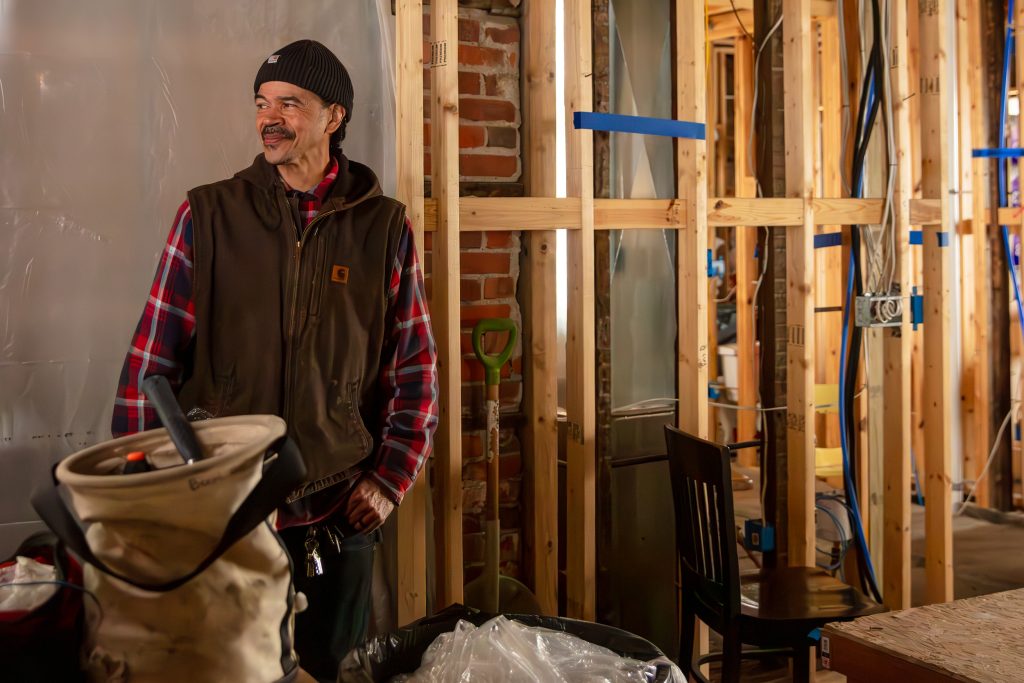
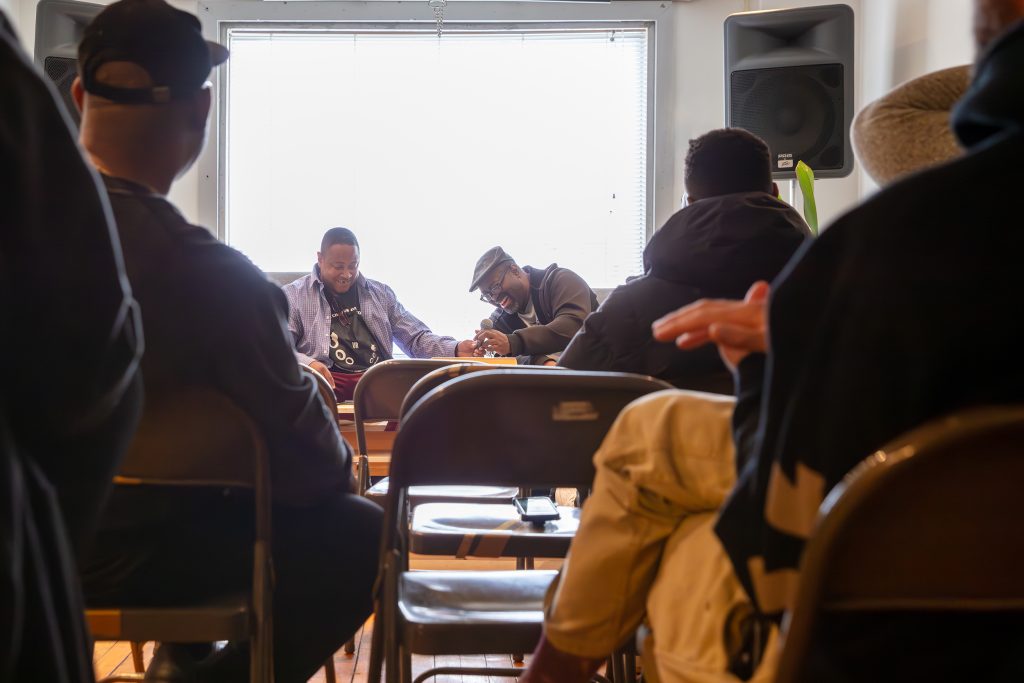
“All of these people are part of a larger community. They sample each other’s stuff. They’re all remixing each other’s stuff and quoting each other’s sounds. Coming from a classical background, I recognized the importance of the sharing between members of this community.” –Maritza Figueroa-Garibay
Listening to the People
“All you gotta do is listen to the people you sell the records to. They’ll tell you every part that’s needed. With electronic music, it’s a lot of interactive with the tribe, with the people.” –“Mad” Mike Banks
“Places like Submerge are part of this community. We’re neighbors. It’s not like I had to do an audition and tap dance and stuff to get in. Someone wanted to give me a chance I didn’t even know I was even looking for. And now I’ve been here for like two years.” –Saylem Celeste
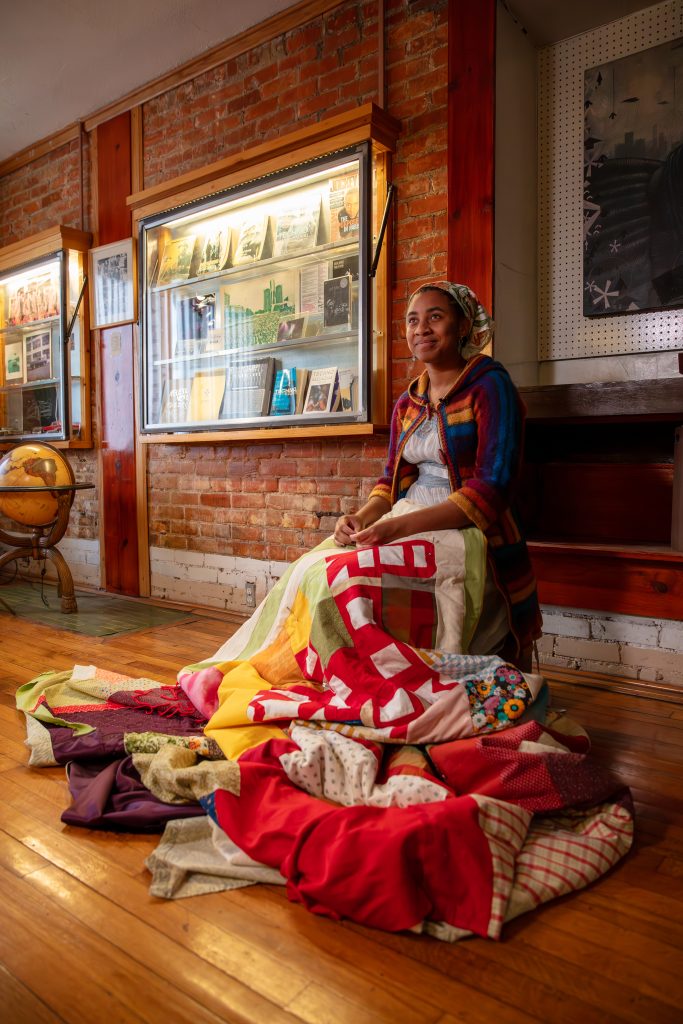
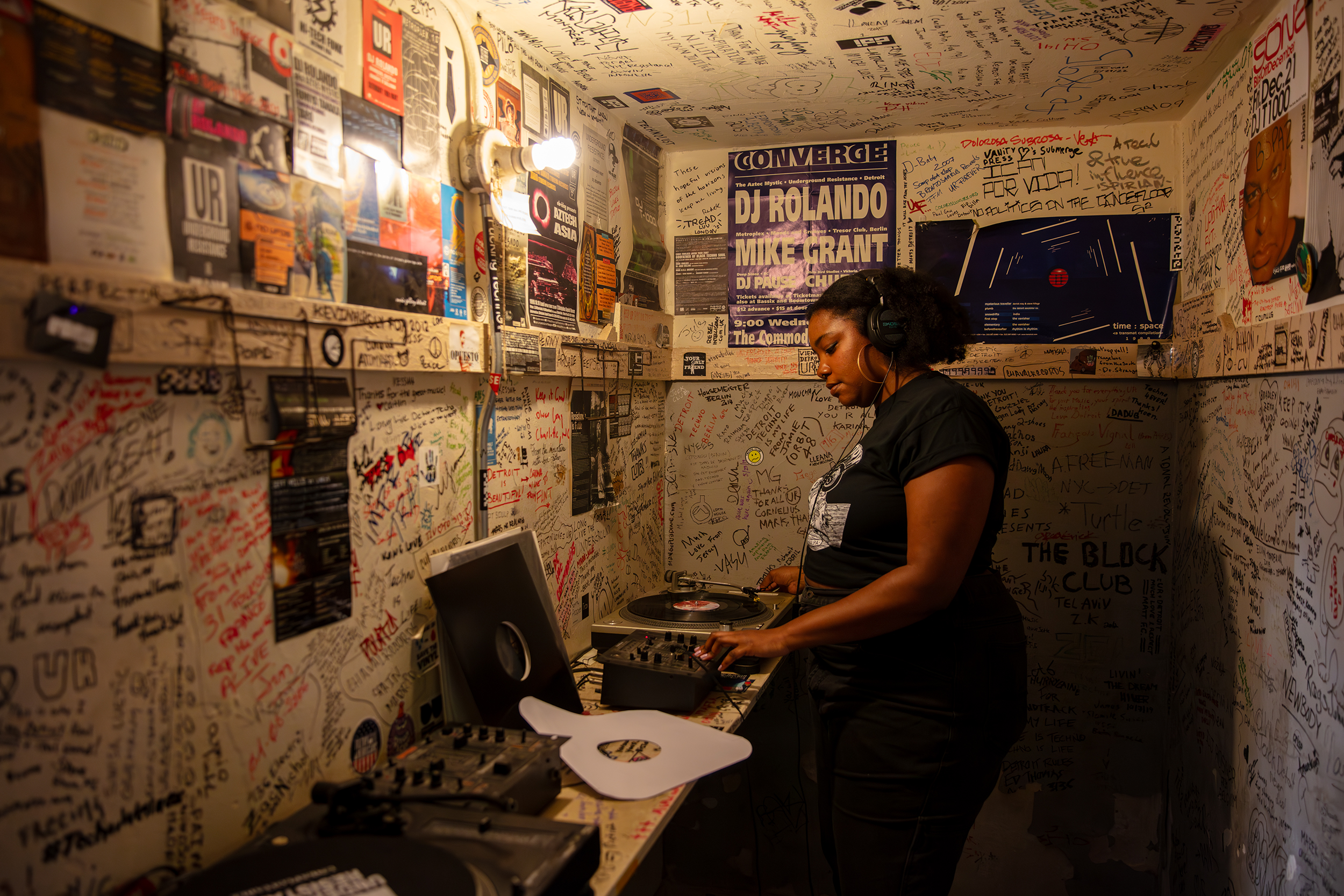
“With the international attention Detroit techno has gotten, they can kick it at a global level to finally give Detroit a real permanent record store. That’s a big component. It’s a focal point for Detroit residents to get involved with the future.” –“Mad” Mike Banks
Collective Wisdom
“UR is a record label and a production team—it’s also a collective. They’re all valid. Submerge started off as distribution. It’s become many different things, and they all work together. We all cross over.” –Cornelius Harris
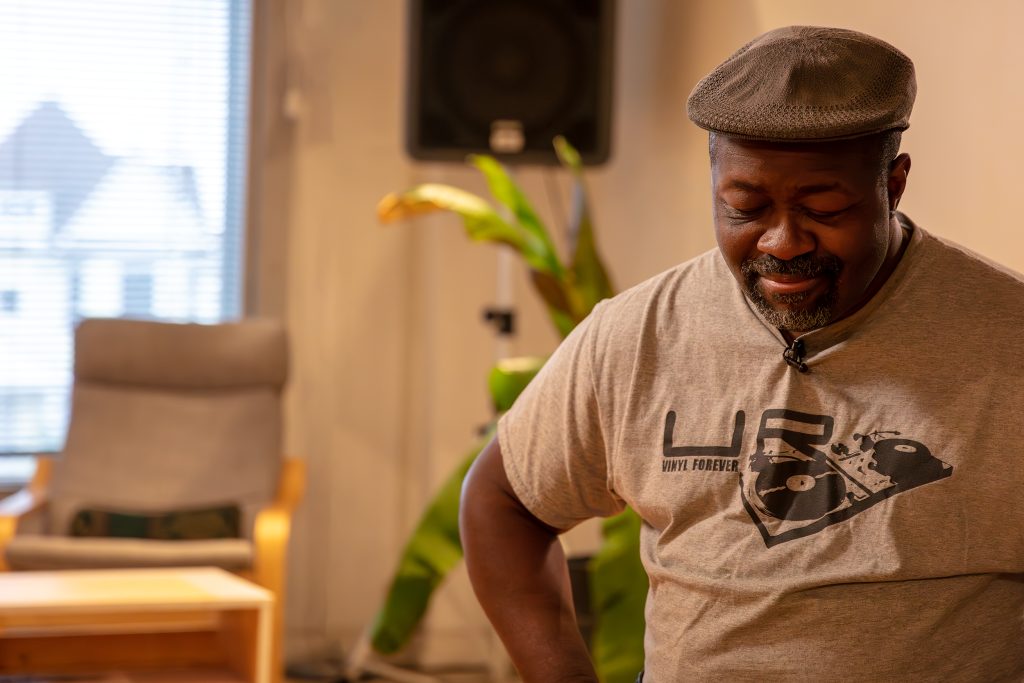
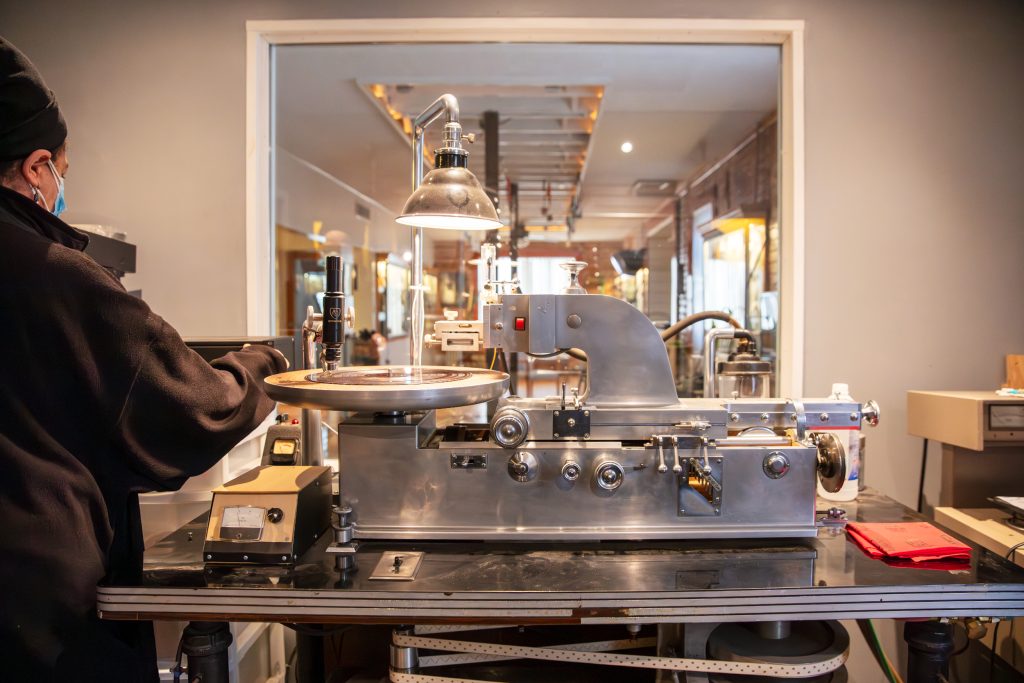
“I started off as the International Affairs Coordinator dealing with mechanical royalties. Then I became the shipper. We all wear many different hats.
We try to get young people so they can appreciate it from the bottom up. They help me take all these boxes to the post office, take them to the plant.” –Bridgette Banks
“Distributors, producers, and labels understand the importance of putting a record here. It’s not just to sell the record, but it’s to contribute to the archival element of Submerge and Exhibit 3000. It’s making sure you’re included in the history part.” –Crystal Mioner
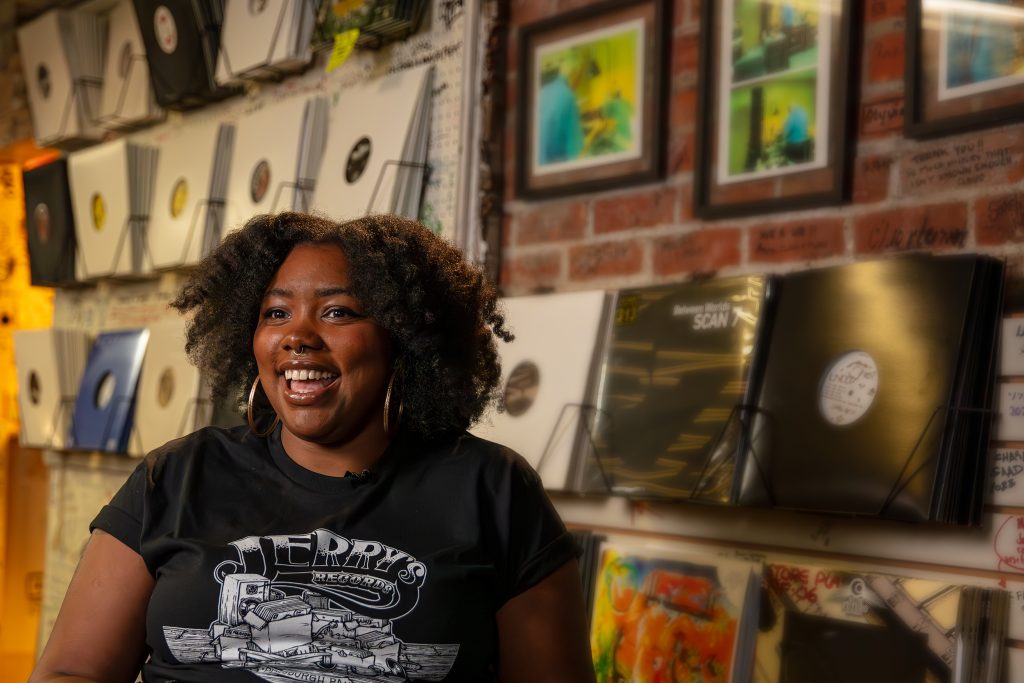

Raw Honesty
“I would research all these different locations, and I saw Submerge listed as one of the record stores. I’d walk by and wonder if this is the spot. That raw, honest sound, I just think of Motown. UR embodies it, but the history before it also embodies it.” –Kamau Baaqi
“Mike and his sister jumped on board as distributors for the record I’d done with J Dilla. He had these beats he wasn’t playing for the Pharcyde, he wasn’t playing for Tribe. It reminded me of my art training and what our teacher taught us about the Da Vinci sketchbook.” –Waajeed
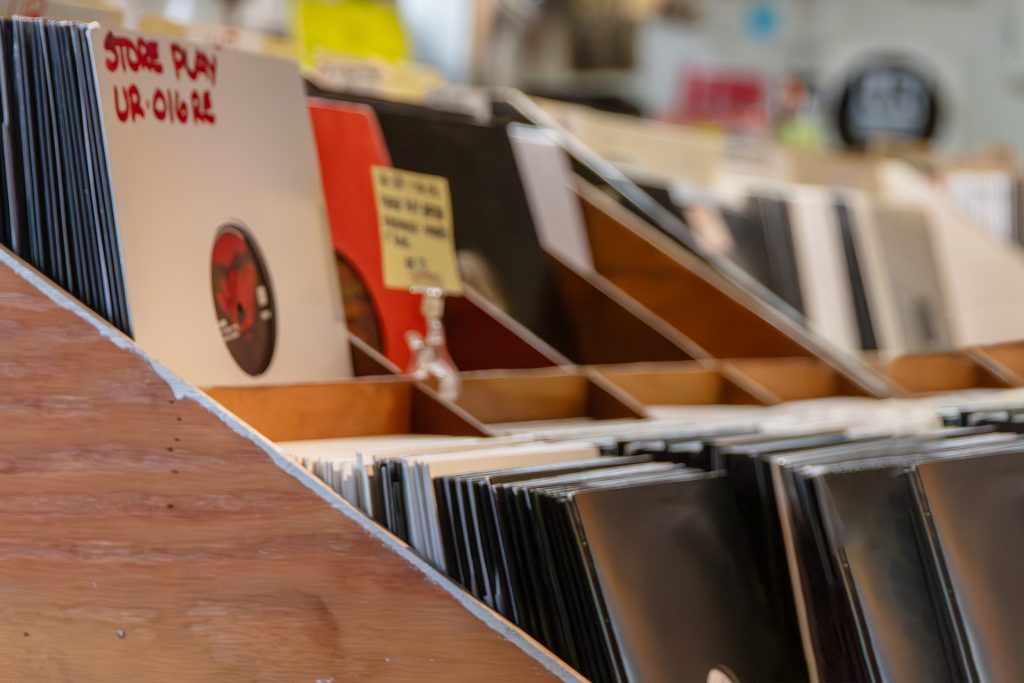
“You would see this lone person with a huge backpack looking around. We’d go to the door and say, ‘You looking for Submerge? Come on in.’ You could just tell. They would stay the whole day, digging through records.” –Bridgette Banks
A BEACON OF THE CULTURE
“It’s the history of music, of Detroit, of fighting, of love, of friendship, of frustration. I’ve seen people cry before on the steps. The building is a home for many people you wouldn’t expect. It’s such a beacon of the culture and the music.” –Crystal Mioner
“UR is there, and it’s many of us.” –“Mad” Mike Banks
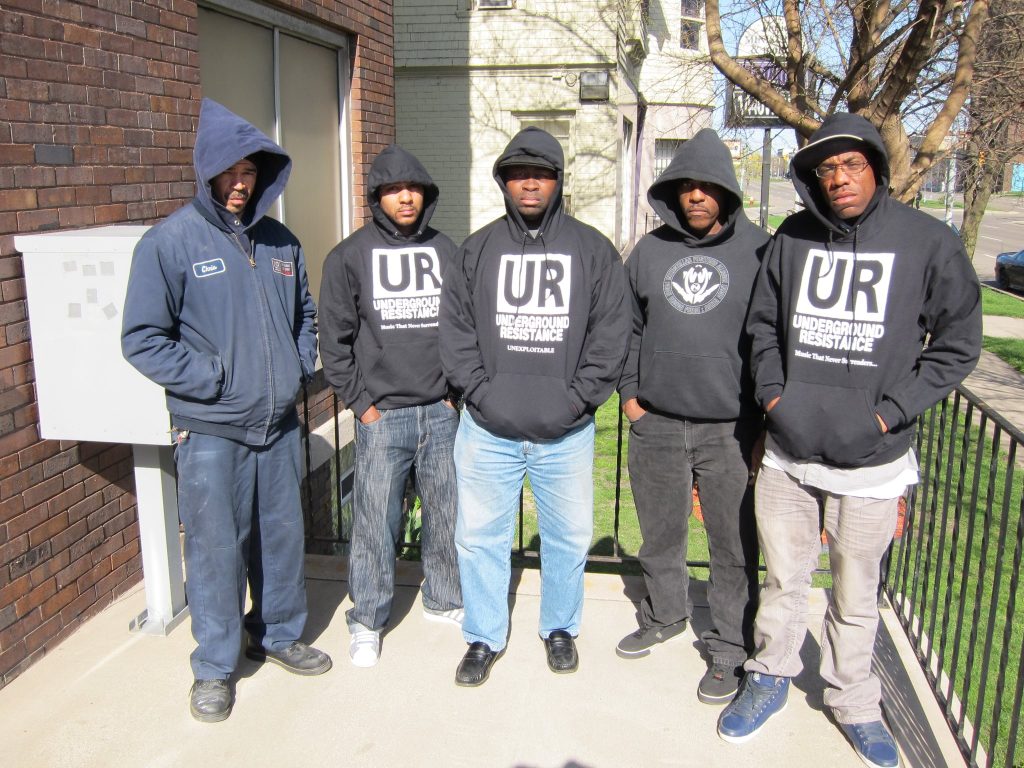
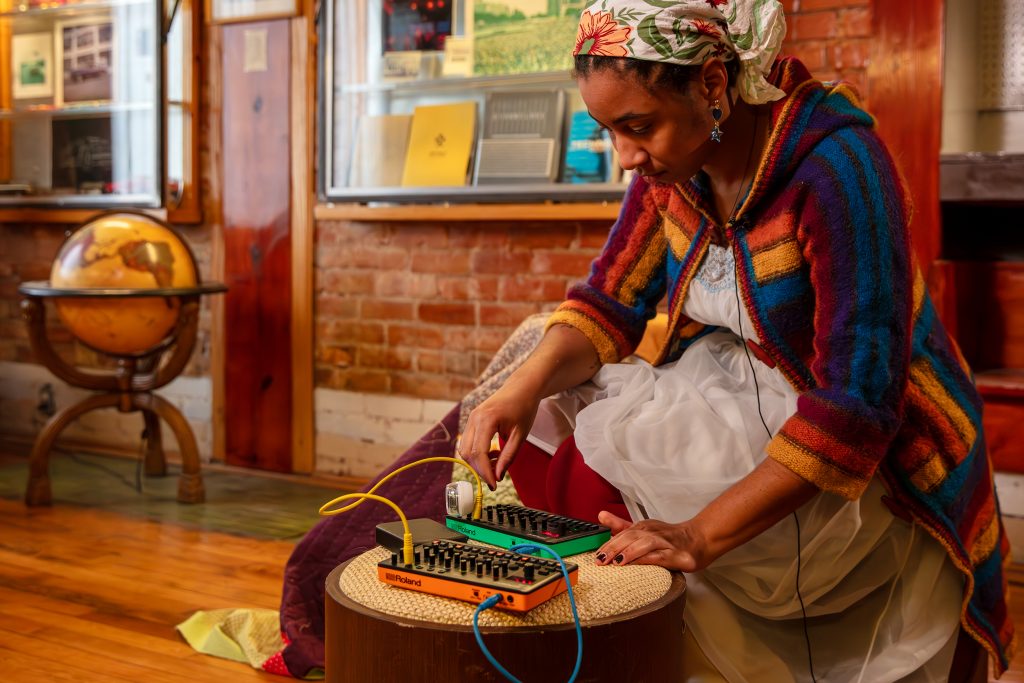
“Ability to have information and knowledge in a town like this saves people from quitting and being in harmful, unsafe environments. Places like Submerge are like safe zones or havens where people can come and get that care.” –Saylem Celeste
“It goes so far beyond genre that it allows expansiveness, even in who’s walking through the door. It’s all about the sound, the underlying message. My best friends work and live throughout the building, so it’s super dope in that regard.” –Crystal Mioner

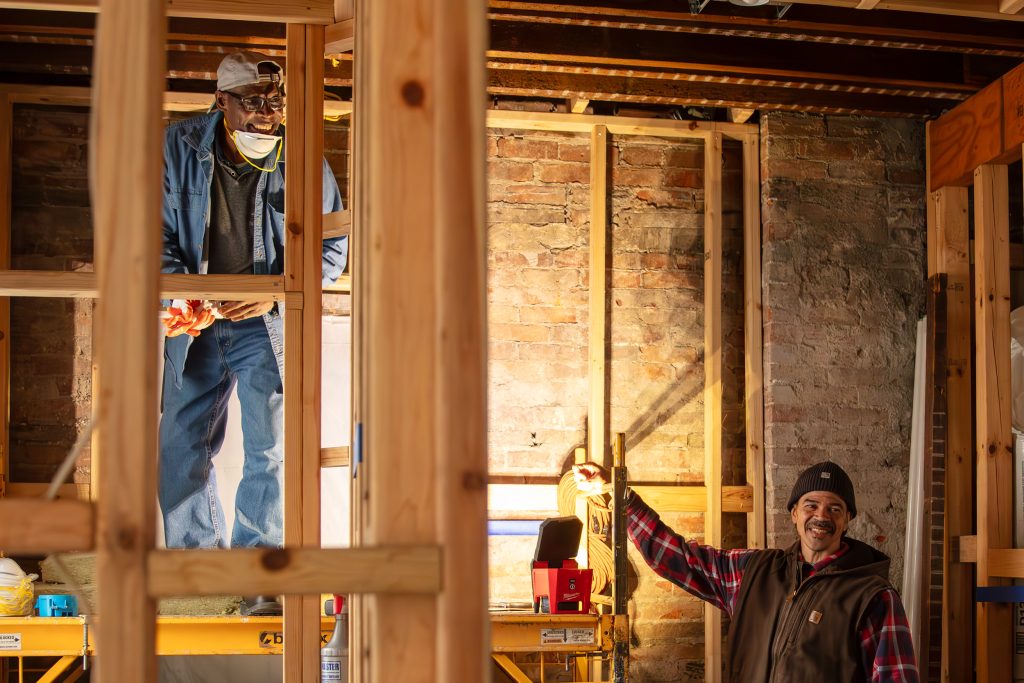
“At Submerge, you see artists coming through and supporting each other and working on the building. Folks contribute their time to help these kids learn about this stuff. It’s a real community building mentality going on.” –Maritza Figueroa-Garibay
In 1990, a group of Detroit electronic artists striving for musical, business, and aesthetic independence formed a label: Underground Resistance. As the art form and its fanbase grew, Submerge was born to distribute the collective’s music globally—and that of the burgeoning techno scene. Submerge now acts as a collective—including Exhibit 3000 museum, recording studios, and a record store—all supporting local artists. To this day, Underground Resistance and Submerge continue to provide raw, curated techno to the world.
Building Potential
“Being a futurist, I like to build potential. Build it, and they will come.” –“Mad” Mike Banks
“Why wait for somebody when that somebody could be you?” –Cornelius Harris

“All of these people are part of a larger community. They sample each other’s stuff. They’re all remixing each other’s stuff and quoting each other’s sounds. Coming from a classical background, I recognized the importance of the sharing between members of this community.” –Maritza Figueroa-Garibay

Listening to the People
“All you gotta do is listen to the people you sell the records to. They’ll tell you every part that’s needed. With electronic music, it’s a lot of interactive with the tribe, with the people.” –“Mad” Mike Banks
“Places like Submerge are part of this community. We’re neighbors. It’s not like I had to do an audition and tap dance and stuff to get in. Someone wanted to give me a chance I didn’t even know I was even looking for. And now I’ve been here for like two years.” –Saylem Celeste
“With the international attention Detroit techno has gotten, they can kick it at a global level to finally give Detroit a real permanent record store. That’s a big component. It’s a focal point for Detroit residents to get involved with the future.” –“Mad” Mike Banks


Collective Wisdom
“UR is a record label and a production team—it’s also a collective. They’re all valid. Submerge started off as distribution. It’s become many different things, and they all work together. We all cross over.” –Cornelius Harris

“I started off as the International Affairs Coordinator dealing with mechanical royalties. Then I became the shipper. We all wear many different hats.
We try to get young people so they can appreciate it from the bottom up. They help me take all these boxes to the post office, take them to the plant.” –Bridgette Banks

“Distributors, producers, and labels understand the importance of putting a record here. It’s not just to sell the record, but it’s to contribute to the archival element of Submerge and Exhibit 3000. It’s making sure you’re included in the history part.” –Crystal Mioner

Raw Honesty
“I would research all these different locations, and I saw Submerge listed as one of the record stores. I’d walk by and wonder if this is the spot. That raw, honest sound, I just think of Motown. UR embodies it, but the history before it also embodies it.” –Kamau Baaqi

“Mike and his sister jumped on board as distributors for the record I’d done with J Dilla. He had these beats he wasn’t playing for the Pharcyde, he wasn’t playing for Tribe. It reminded me of my art training and what our teacher taught us about the Da Vinci sketchbook.” –Waajeed
“You would see this lone person with a huge backpack looking around. We’d go to the door and say, ‘You looking for Submerge? Come on in.’ You could just tell. They would stay the whole day, digging through records.” –Bridgette Banks

A Beacon of the Culture
“It’s the history of music, of Detroit, of fighting, of love, of friendship, of frustration. I’ve seen people cry before on the steps. The building is a home for many people you wouldn’t expect. It’s such a beacon of the culture and the music.” –Crystal Mioner
“UR is there, and it’s many of us.” –“Mad” Mike Banks

“Ability to have information and knowledge in a town like this saves people from quitting and being in harmful, unsafe environments. Places like Submerge are like safe zones or havens where people can come and get that care.” –Saylem Celeste

“It goes so far beyond genre that it allows expansiveness, even in who’s walking through the door. It’s all about the sound, the underlying message. My best friends work and live throughout the building, so it’s super dope in that regard. –Crystal Mioner “

“At Submerge, you see artists coming through and supporting each other and working on the building. Folks contribute their time to help these kids learn about this stuff. It’s a real community building mentality going on.” –Maritza Figueroa-Garibay

ACKNOWLEDGE THE PAST
ACKNOWLEDGE THE PAST
As a reminder of the often discredited and marginalized community that created what we now call techno, Submerge founded the world’s first recognized museum, Exhibit 3000, to preserve the genre’s origins. In a lovingly assembled environment, the museum celebrates the personalities, achievements, and challenges of Detroit as a whole and Underground Resistance in particular. Through vinyl, flyers, artwork, and assorted physical media, it contains the true origin story of Detroit techno.
As a reminder of the often discredited and marginalized community that created what we now call techno, Submerge founded the world’s first recognized museum, Exhibit 3000, to preserve the genre’s origins. In a lovingly assembled environment, the museum celebrates the personalities, achievements, and challenges of Detroit as a whole and Underground Resistance in particular. Through vinyl, flyers, artwork, and assorted physical media, it contains the true origin story of Detroit techno.
Impact and Service
“When I saw the impact that electronic music from Detroit has, I knew I owed it to them to build a museum. This is all part of the synergy of what we do here. People come to Detroit, and they want to see or at least touch some Detroit techno.” –“Mad” Mike Banks
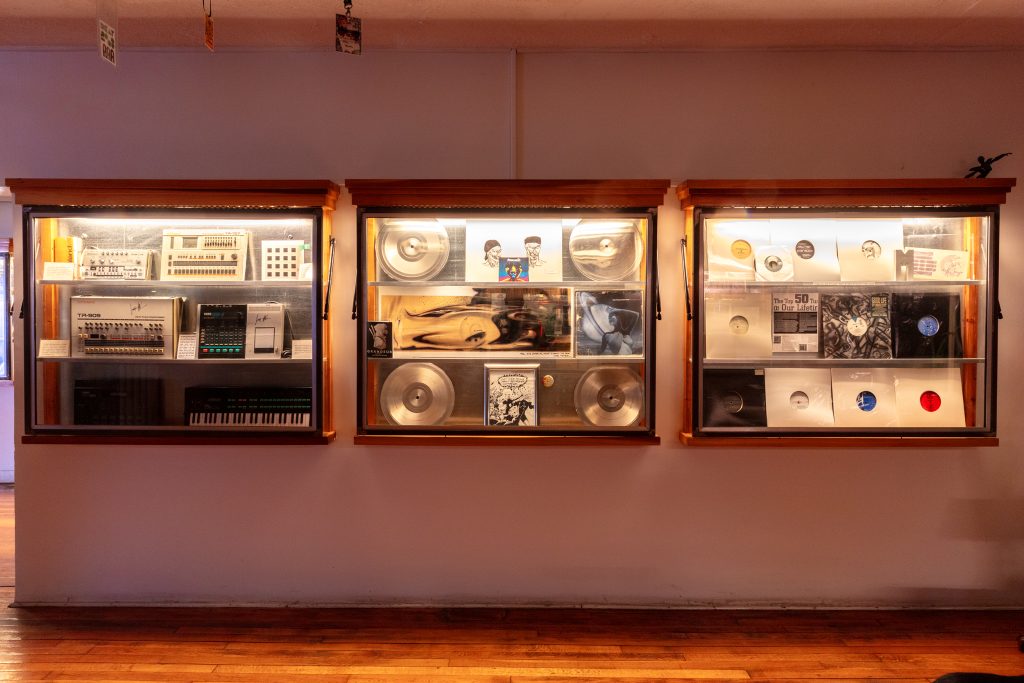
“There’s a certain aesthetic to be had in being the provider that nobody even knows exists. There’s a pleasure in the service. Being on this block and sharing these stories.” –Waajeed
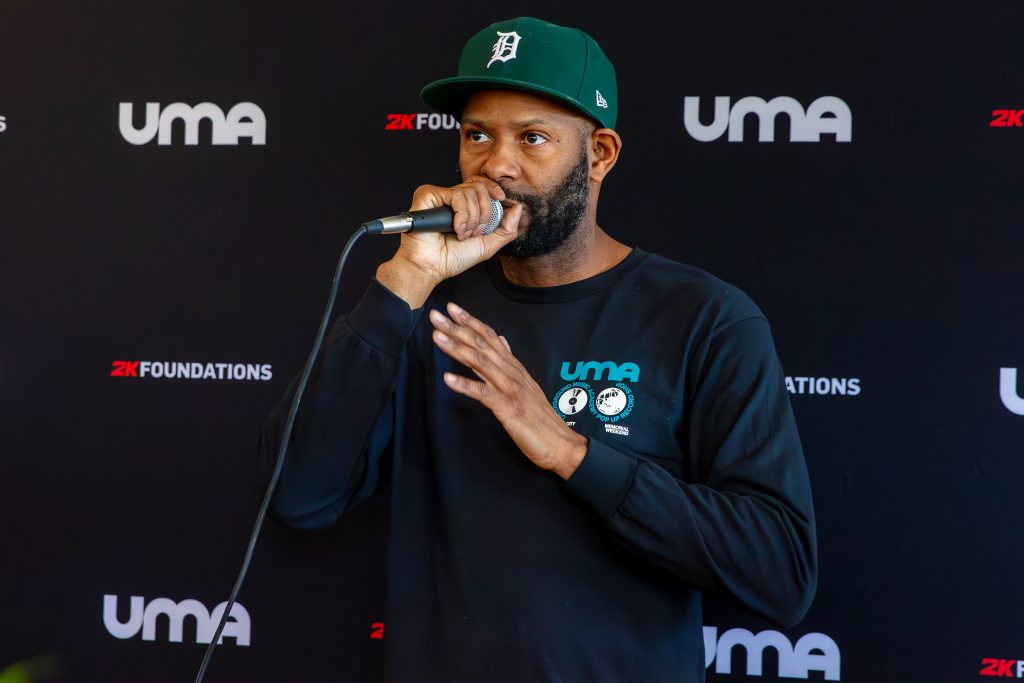
“You can feel the layers of information you are getting. You’ll see something that works that’s tried and tested. My mom was adamant about me learning the standards for the world we live in now. As I learn more about UR, I get the same fulfillment. At Submerge, you learn about your history.” –Kamau Baaqi
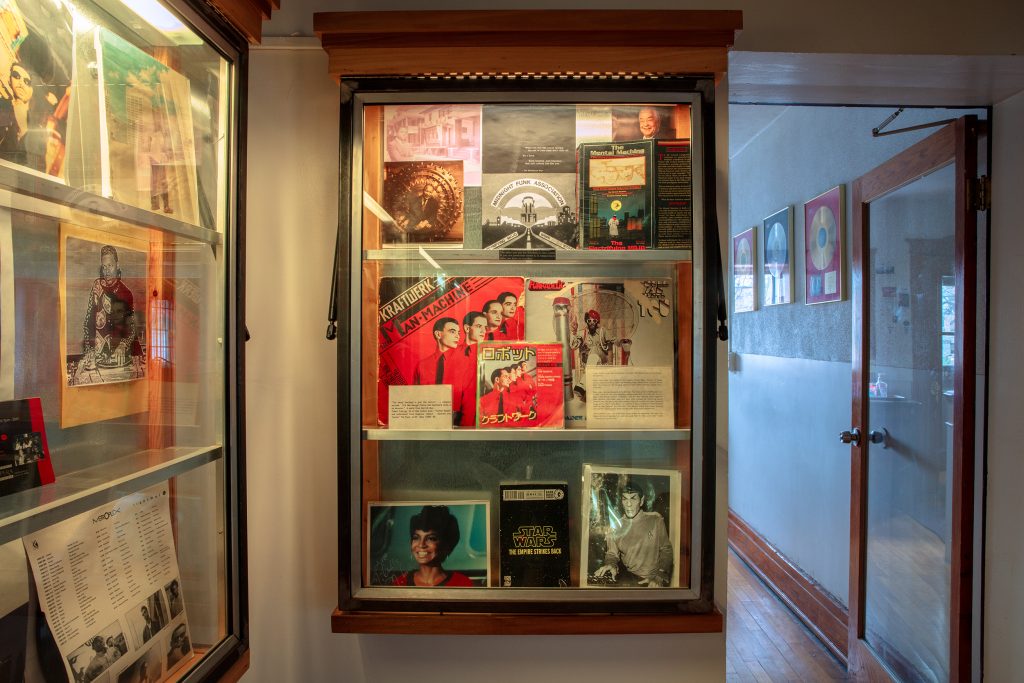
“We have fun with the music, but we can also use it to expand what people know. And it doesn’t have to be in a classroom. For people that just want to enjoy the music they can just enjoy it, and have a great time. But anybody who wants to dig a little bit deeper, they can explore that.” –Cornelius Harris

“A guy who worked at the library would bring an after-school program. He played a Missy Elliott song using a sample, and the kids started dancing. Then he played the original and told them those people you love are rapping over the original. You can see that a classic is a classic.” –Bridgette Banks

History Lesson
“It’s a physical embodiment of the spirit that Mike has championed through everything else. So it feels experimental. It’s made me a fuller person.” –Crystal Mioner
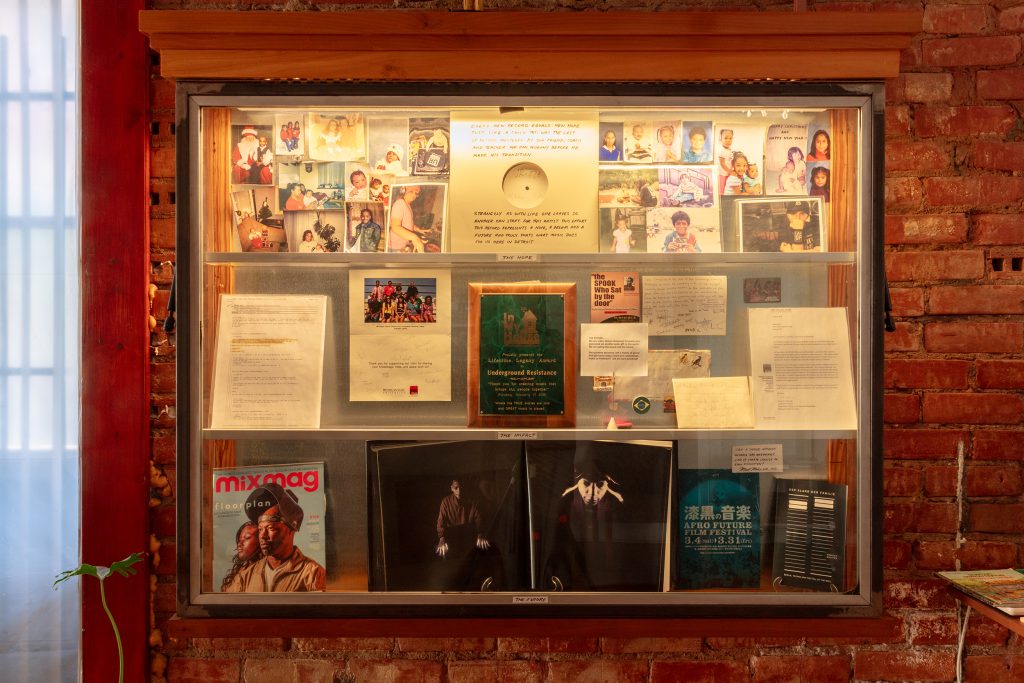
“The good part of seeing it from the bottom up is you have an understanding. It just doesn’t magically happen. A lot of time and effort goes into creativity.” –Bridgette Banks
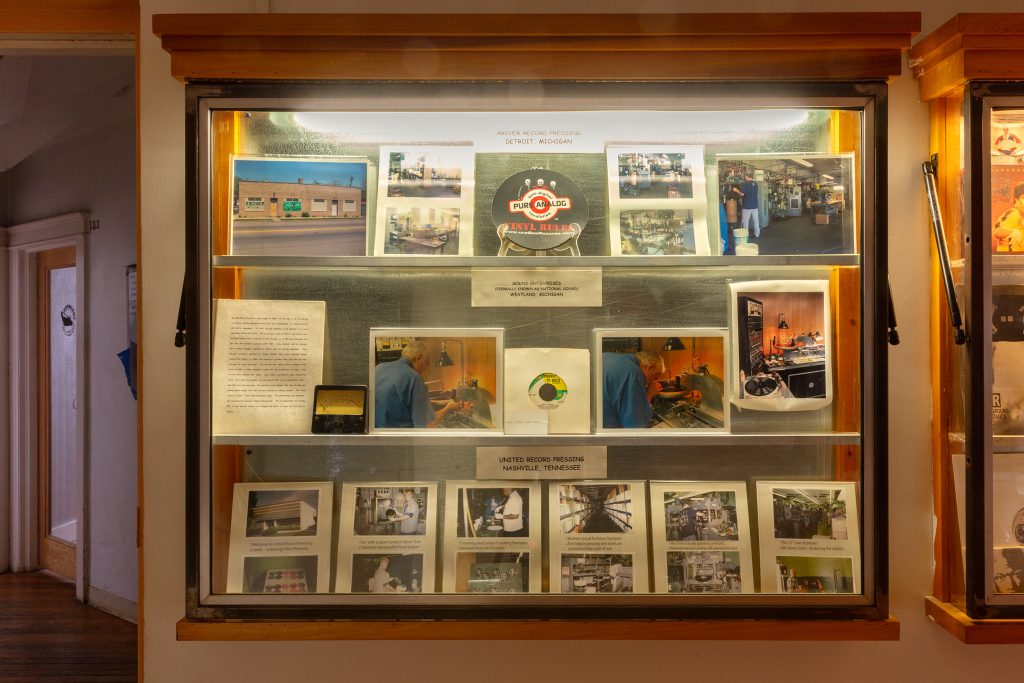
“It’s a consistent history lesson. There’s a consistent opportunity for young people from Detroit to appreciate something that is actually theirs. This is our music. These are our heroes.” –De’Sean Jones
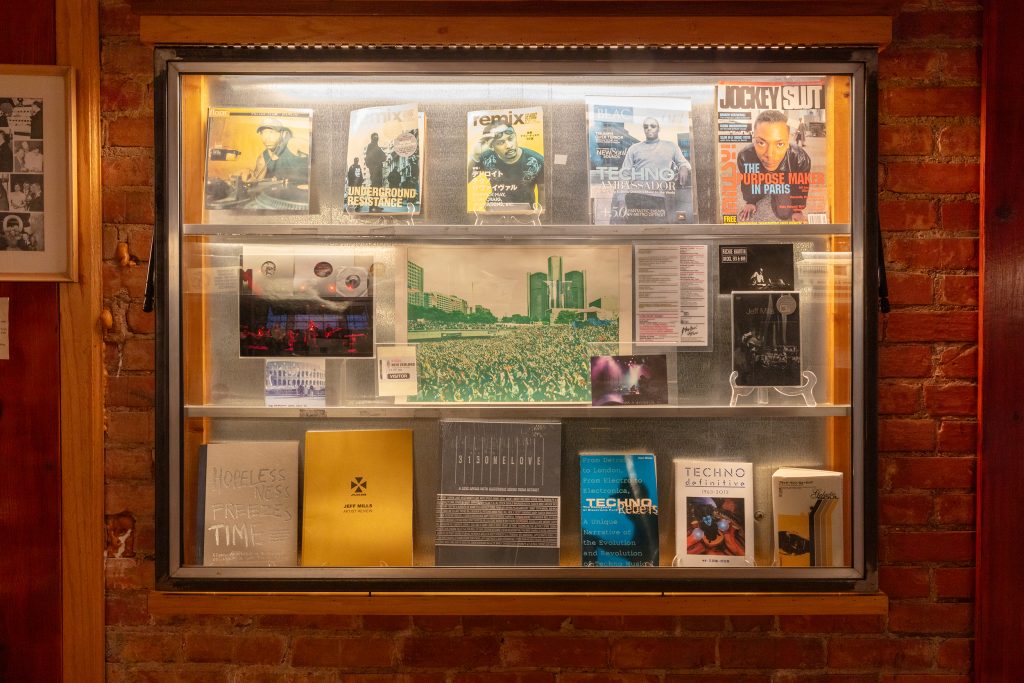
“I was able to bypass a lot of misinformation on the internet and get the information from the source. I’m blessed to be able to learn from my colleagues. I recommend getting involved in what’s around you so you can get that real depth.” –Kamau Baaqi

“Usually, as African American artists, we get x-ed out of history. Luckily for us, we was twenty years early.” –“Mad” Mike Banks
“Some museums have gift shops—Exhibit 3000 has a record store.” –Bridgette Banks
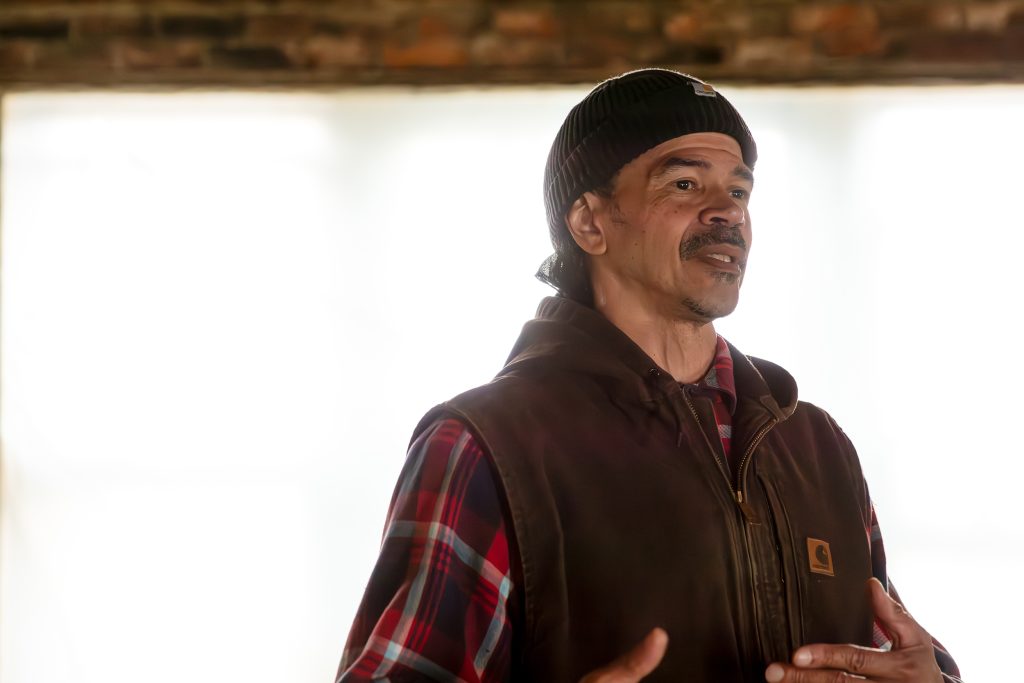

Impact and Service
“When I saw the impact that electronic music from Detroit has, I knew I owed it to them to build a museum. This is all part of the synergy of what we do here. People come to Detroit, and they want to see or at least touch some Detroit techno.” –“Mad” Mike Banks
“There’s a certain aesthetic to be had in being the provider that nobody even knows exists. There’s a pleasure in the service. Being on this block and sharing these stories.” –Waajeed


“You can feel the layers of information you are getting. You’ll see something that works that’s tried and tested. My mom was adamant about me learning the standards for the world we live in now. As I learn more about UR, I get the same fulfillment. At Submerge, you learn about your history.” –Kamau Baaqi
“We have fun with the music, but we can also use it to expand what people know. And it doesn’t have to be in a classroom. For people that just want to enjoy the music they can just enjoy it, and have a great time. But anybody who wants to dig a little bit deeper, they can explore that.” –Cornelius Harris


“A guy who worked at the library would bring an after-school program. He played a Missy Elliott song using a sample, and the kids started dancing. Then he played the original and told them those people you love are rapping over the original. You can see that a classic is a classic.” –Bridgette Banks
History Lesson
“It’s a physical embodiment of the spirit that Mike has championed through everything else. So it feels experimental. It’s made me a fuller person.” –Crystal Mioner


“The good part of seeing it from the bottom up is you have an understanding. It just doesn’t magically happen. A lot of time and effort goes into creativity.” –Bridgette Banks
“It’s a consistent history lesson. There’s a consistent opportunity for young people from Detroit to appreciate something that is actually theirs. This is our music. These are our heroes.” –De’Sean Jones


“I was able to bypass a lot of misinformation on the internet and get the information from the source. I’m blessed to be able to learn from my colleagues. I recommend getting involved in what’s around you so you can get that real depth.” –Kamau Baaqi
“Usually, as African American artists, we get x-ed out of history. Luckily for us, we was twenty years early.” –“Mad” Mike Banks
“Some museums have gift shops—Exhibit 3000 has a record store.” –Bridgette Banks

FOSTERING THE FUTURE
FOSTERING THE FUTURE
As home to the revered Detroit School of Arts, it’s no surprise that music education plays a vital role in Detroit’s past, present, and future. The presence of prodigies from every performance discipline speaks to the city’s endless talent pool. Underground Music Academy, an extension of the values of Underground Resistance, Submerge, techno, and the Detroit community, continues to inspire the next generation of artists.
Legacy
“It’s essential Detroit stays in the electronic music game. When you remove the colors, you gonna lose the future Juan Atkins, J Dilla.” –“Mad” Mike Banks

As home to the revered Detroit School of Arts, it’s no surprise that music education plays a vital role in Detroit’s past, present, and future. The presence of prodigies from every performance discipline speaks to the city’s endless talent pool. Underground Music Academy, an extension of the values of Underground Resistance, Submerge, techno, and the Detroit community, continues to inspire the next generation of artists.
Legacy
“It’s essential Detroit stays in the electronic music game. When you remove the colors, you gonna lose the future Juan Atkins, J Dilla.” –“Mad” Mike Banks

“Detroit techno is a huge part of the legacy of Black music in the city. Teaching at Detroit School of Arts, I’ve become a part of this community of young musicians. It’s important they understand the weight and responsibility of sharing that legacy.” –Maritza Figueroa-Garibay

“This building was graciously sold to us by the NAACP. They wanted to see something good happen. They do civil rights work for Black folks and people of color all over the country. They were fighting for our future. So in a weird way, the building is still doing it.” –“Mad” Mike Banks

Lifting Each Other Up
“You can’t predict the future. When you hear what these folks are working on, hear the diversity of sounds, you know anything could happen.” –Cornelius Harris

“These kids lift each other up. The sense of community in this school is very strong. They all want to perform together, and they all want to see each other do well.” –Maritza Figueroa-Garibay

“I hope our guys in Detroit can always come here, no matter how famous they are. They can teach and be part of this team and keep this going.” –“Mad” Mike Banks
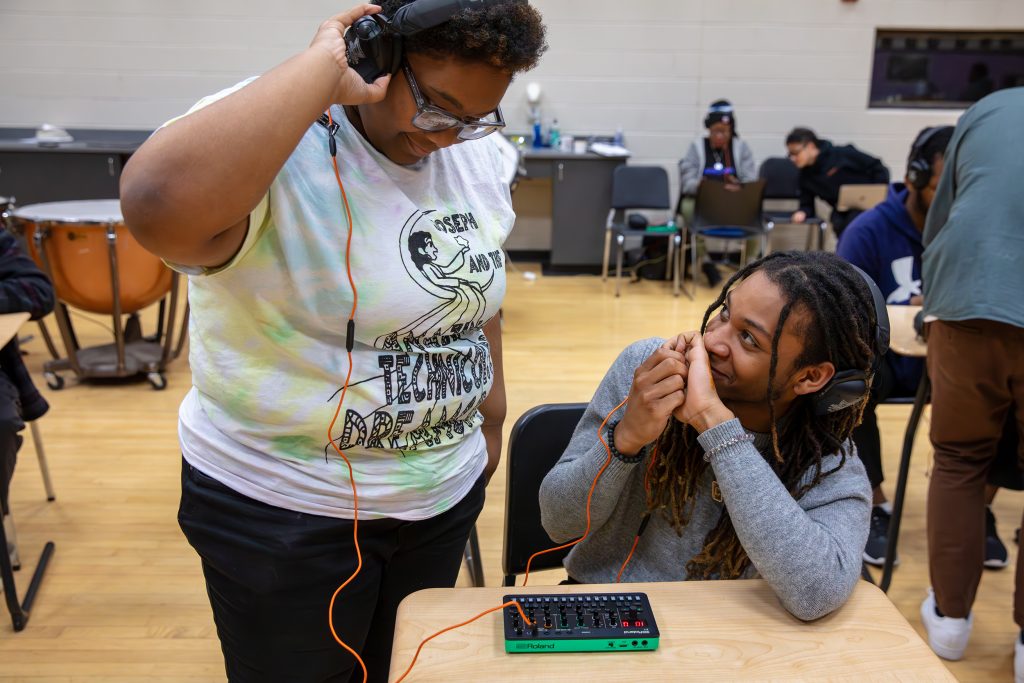
Community
“The neighborhoods are changing. Taxes increase, and people get pushed out because they can’t afford it. Somebody comes with a lot of money and moves in. We just happen to be on the other side of it. For now. Since we’ve been here so long, we might be okay. But, you know, it’s hard to say.” –Bridgette Banks
“A community makes these things possible. No individual can claim this by themselves. Every single one of us has had somebody get behind what we’ve done. For many folks, it was like Marcus Belgrave, who mentored countless musicians.” –Cornelius Harris
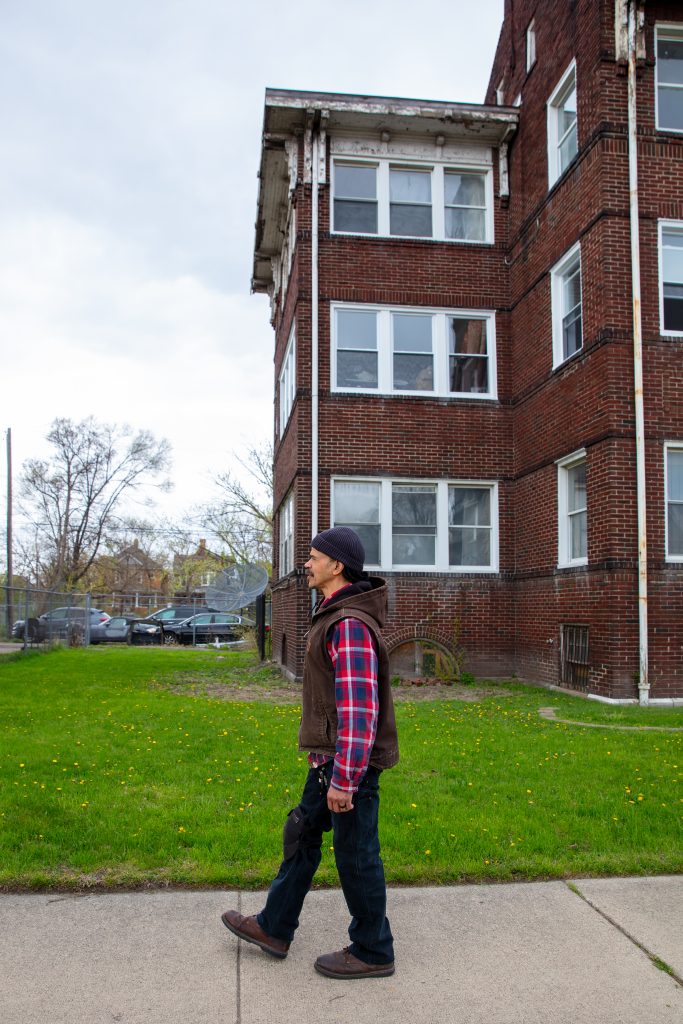
“What I would like to happen is an expansion of the museum space to cover house, hip-hop, and other genres, and more room for our little shop. It would be much more spacious, with the school, all added together.” –Bridgette Banks
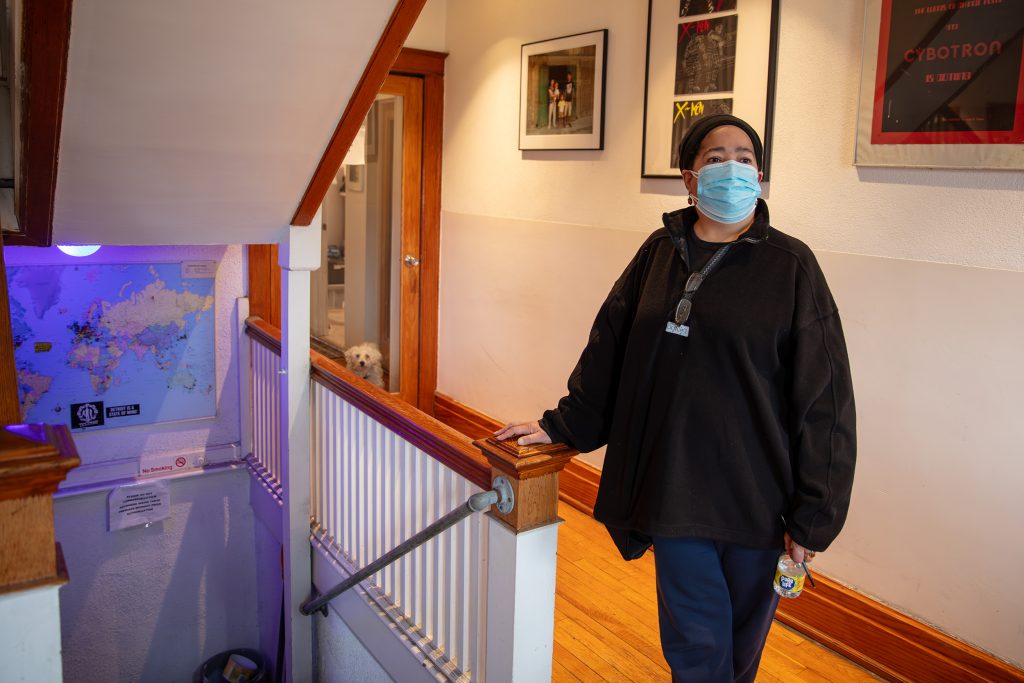
“I would love to see this space continue to do what it did when we cut that ribbon. And that’s to inspire. That’s the bottom line. What I can have this for this place. What do you do with that success? Who do you bring with you? Who do you teach on the way?” –Waajeed
“In Black culture, oral tradition, learning through action, formal learning onstage in front of people, people are paying to see you perform. It’s the combination of all those things that keeps a thorough and well-rounded individual.” –De’Sean Jones
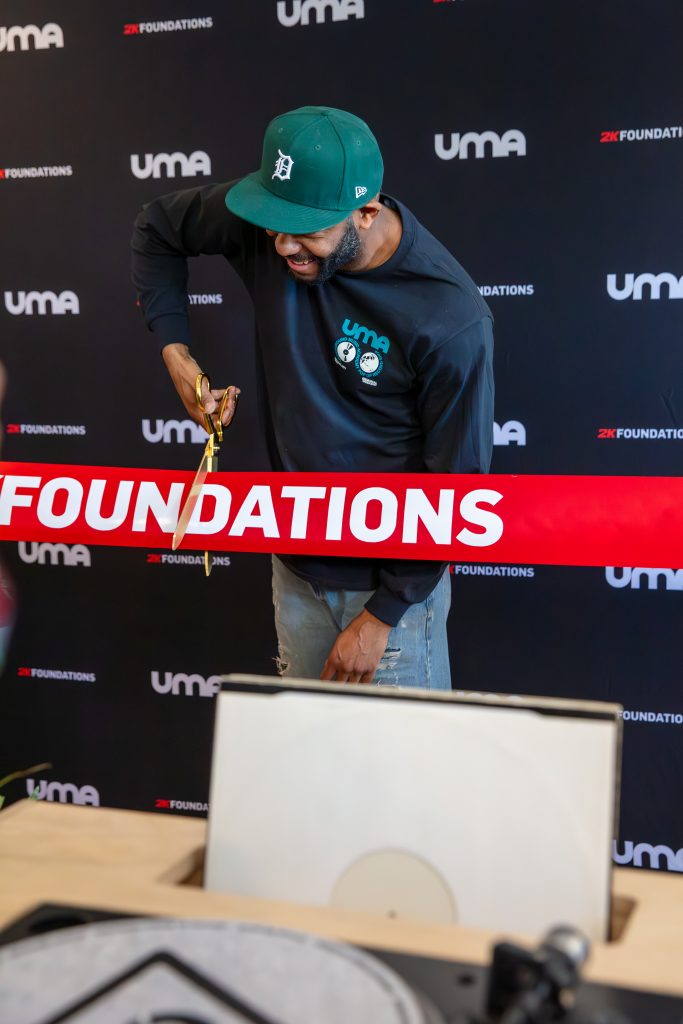
“People like Mike are doing a great job actively believing in people, giving them a shot. The willingness to try and believe matters way more to me than anything else. Because all of this is relationships.” –Saylem Celeste

“Nothing makes me prouder than when little eighth-grade, seventh-grade kids come in and see all these brothers up there with techno going around the world. I think this building has even more potential for that, especially with the school.” –“Mad” Mike Banks


“Detroit techno is a huge part of the legacy of Black music in the city. Teaching at Detroit School of Arts, I’ve become a part of this community of young musicians. It’s important they understand the weight and responsibility of sharing that legacy.” –Maritza Figueroa-Garibay
“This building was graciously sold to us by the NAACP. They wanted to see something good happen. They do civil rights work for Black folks and people of color all over the country. They were fighting for our future. So in a weird way, the building is still doing it.” –“Mad” Mike Banks


Lifting Each Other Up
“You can’t predict the future. When you hear what these folks are working on, hear the diversity of sounds, you know anything could happen.” –Cornelius Harris
“These kids lift each other up. The sense of community in this school is very strong. They all want to perform together, and they all want to see each other do well.” –Maritza Figueroa-Garibay


“I hope our guys in Detroit can always come here, no matter how famous they are. They can teach and be part of this team and keep this going.” –“Mad” Mike Banks
Community
“The neighborhoods are changing. Taxes increase, and people get pushed out because they can’t afford it. Somebody comes with a lot of money and moves in. We just happen to be on the other side of it. For now. Since we’ve been here so long, we might be okay. But, you know, it’s hard to say.” –Bridgette Banks
“A community makes these things possible. No individual can claim this by themselves. Every single one of us has had somebody get behind what we’ve done. For many folks, it was like Marcus Belgrave, who mentored countless musicians.” –Cornelius Harris


“What I would like to happen is an expansion of the museum space to cover house, hip-hop, and other genres, and more room for our little shop. It would be much more spacious, with the school, all added together.” –Bridgette Banks
“I would love to see this space continue to do what it did when we cut that ribbon. And that’s to inspire. That’s the bottom line. What I can have this for this place. What do you do with that success? Who do you bring with you? Who do you teach on the way?” –Waajeed
“In Black culture, oral tradition, learning through action, formal learning onstage in front of people, people are paying to see you perform. It’s the combination of all those things that keeps a thorough and well-rounded individual.” –De’Sean Jones


“People like Mike are doing a great job actively believing in people, giving them a shot. The willingness to try and believe matters way more to me than anything else. Because all of this is relationships.” –Saylem Celeste
“Nothing makes me prouder than when little eighth-grade, seventh-grade kids come in and see all these brothers up there with techno going around the world. I think this building has even more potential for that, especially with the school.” –“Mad” Mike Banks

LISTENING GUIDE
The music of Underground Resistance is as multifaceted as Detroit itself. These tracks serve as an introduction to its futuristic sound and a gateway to further exploration.
